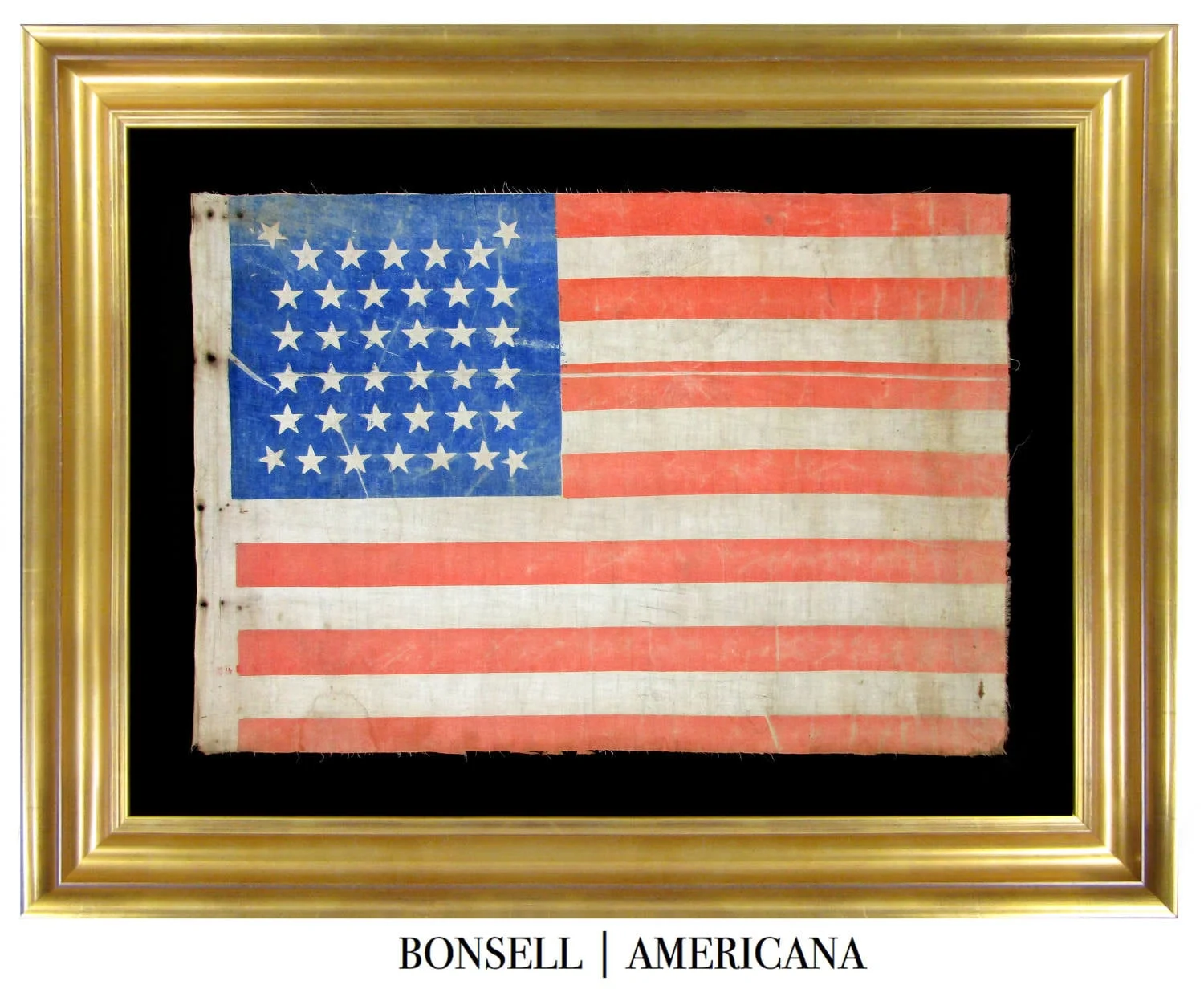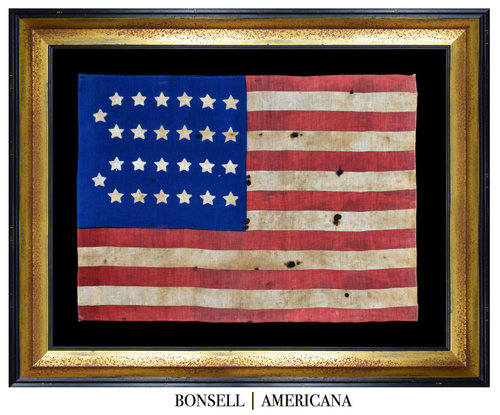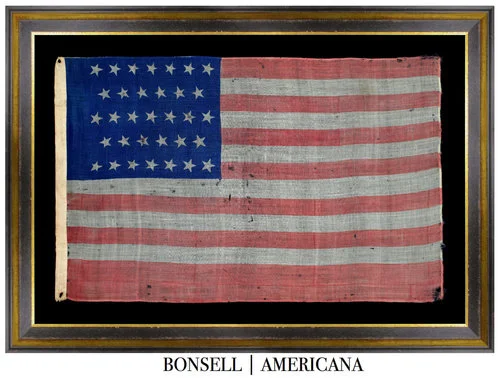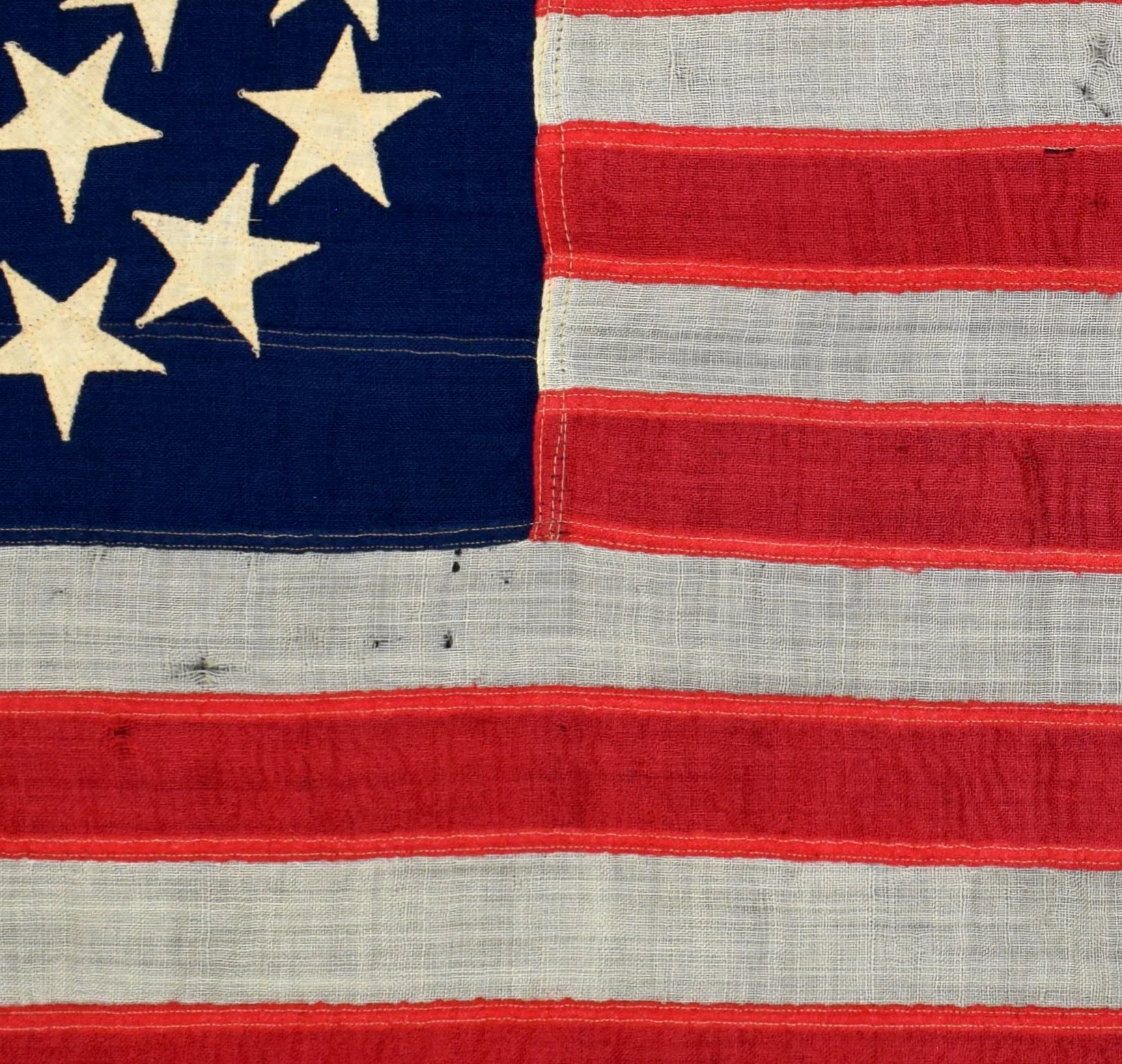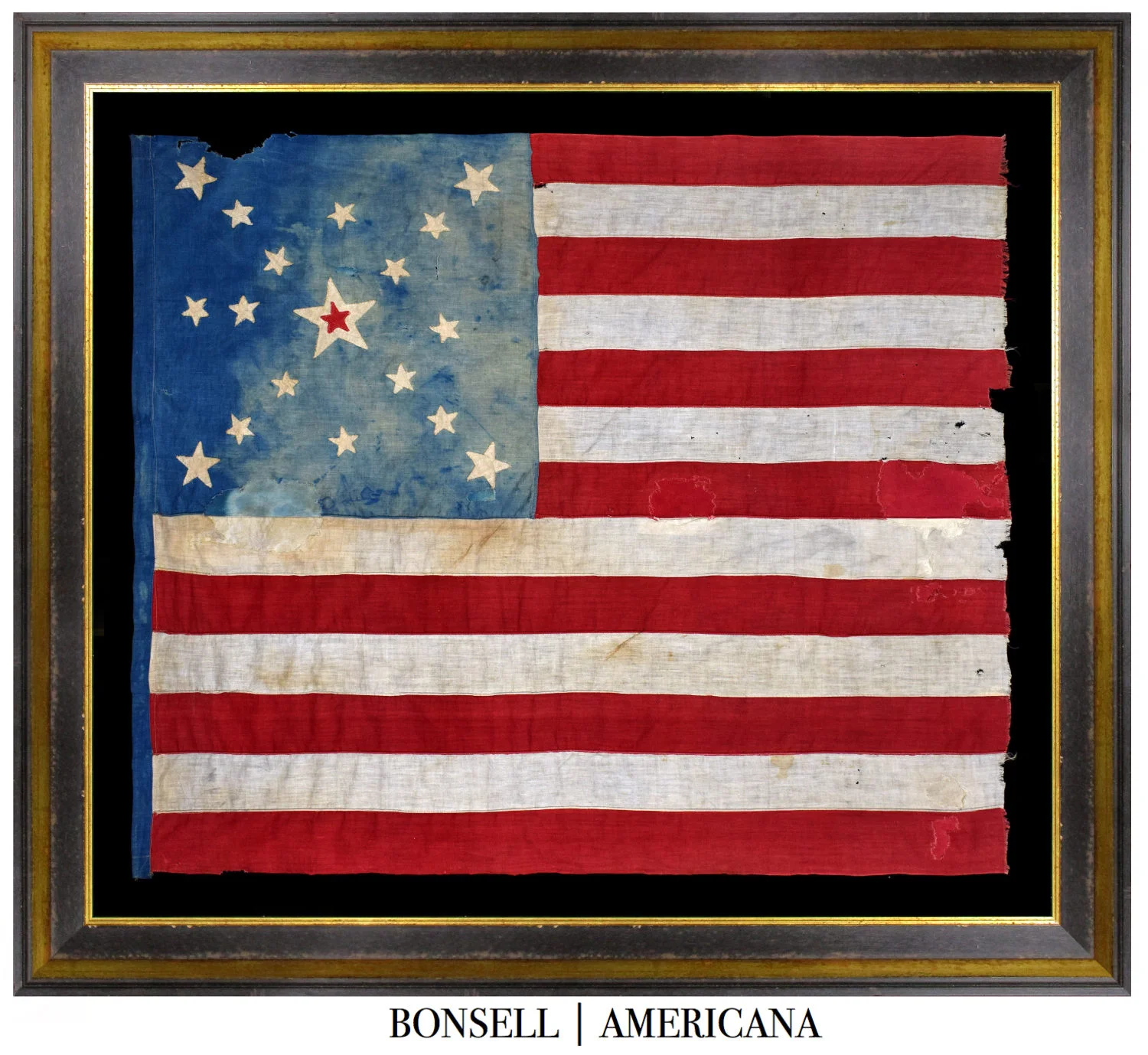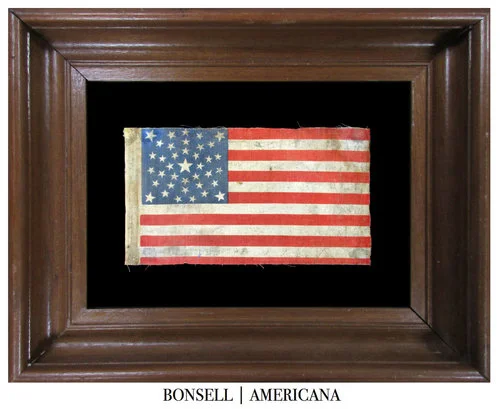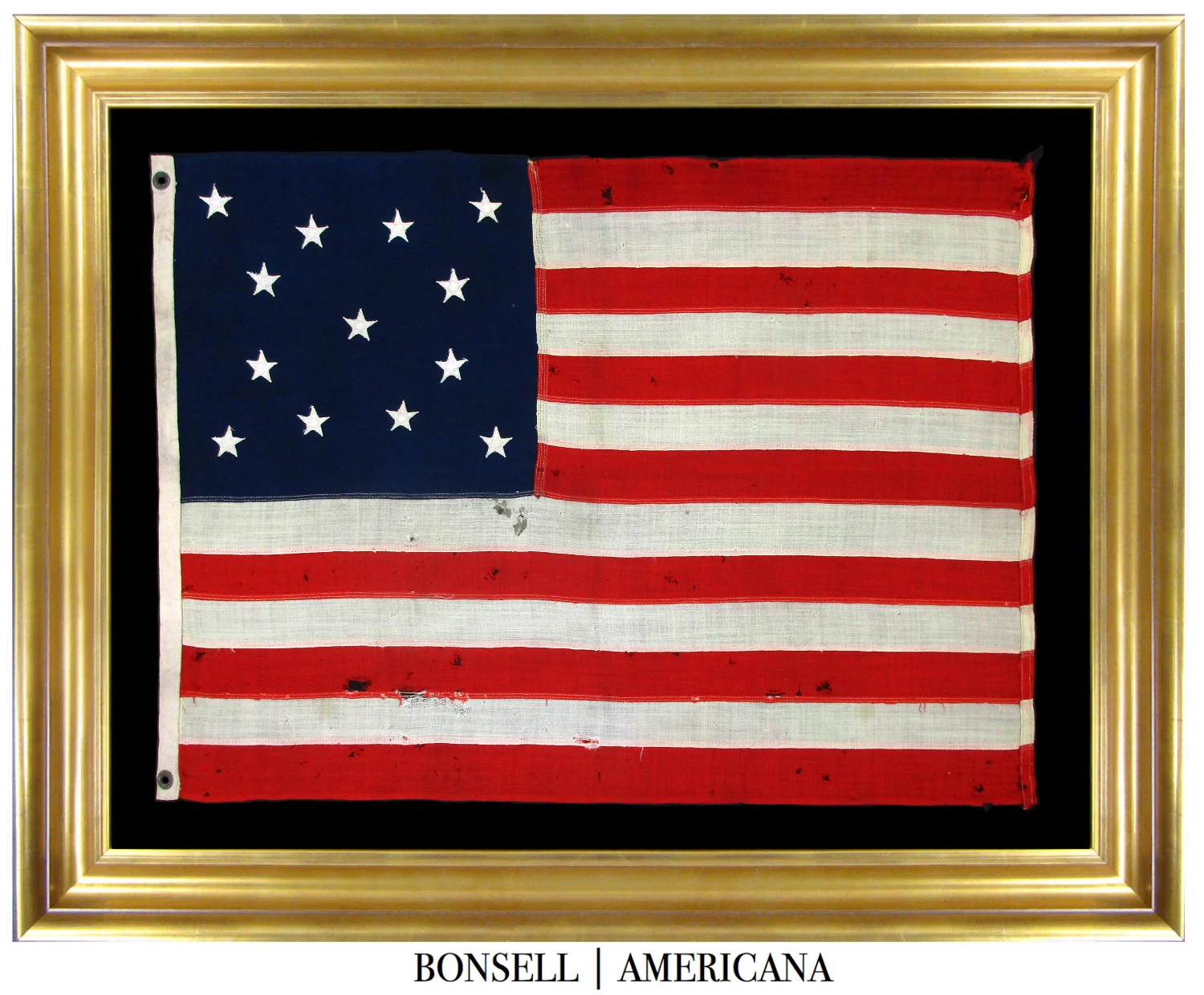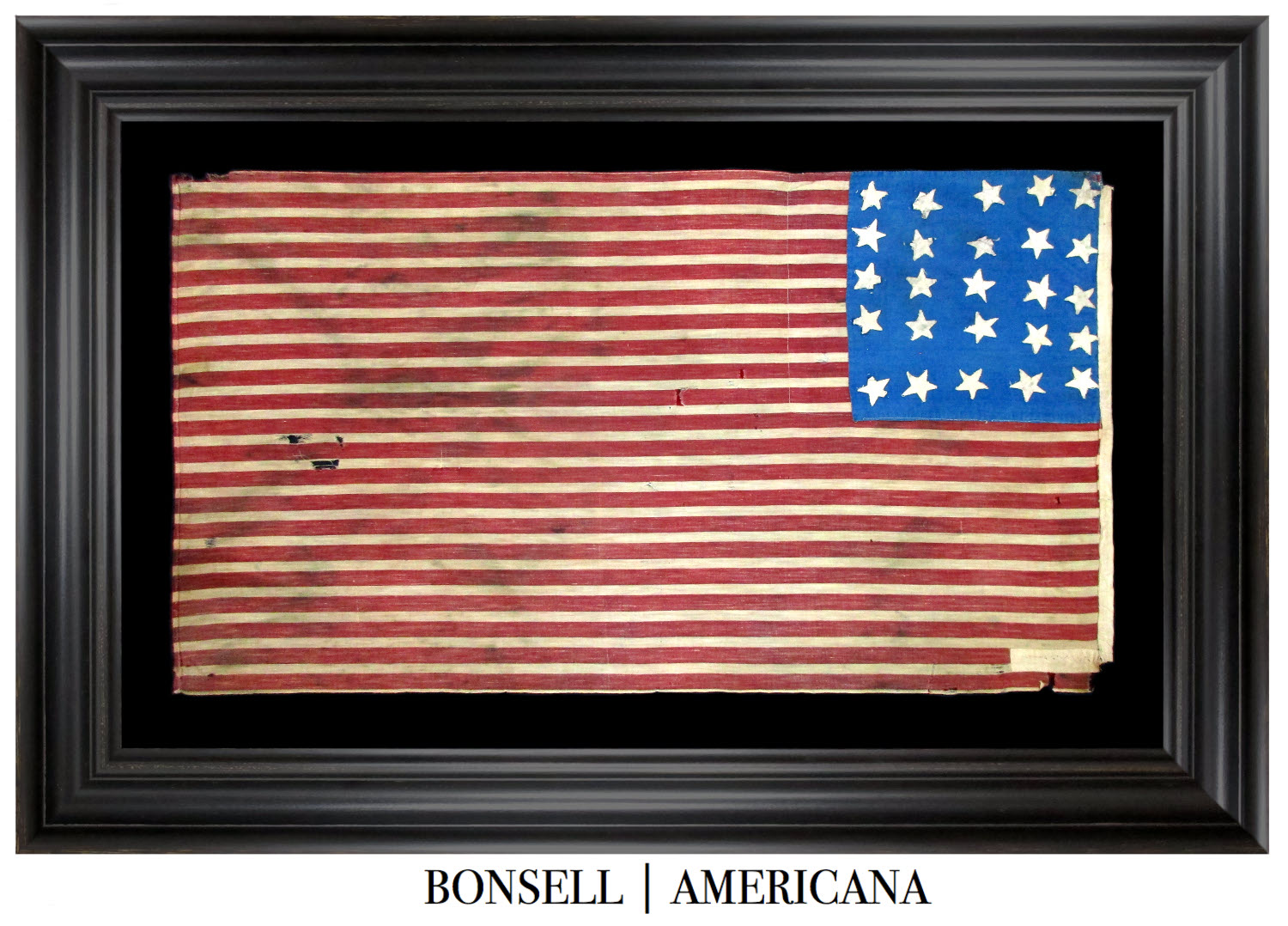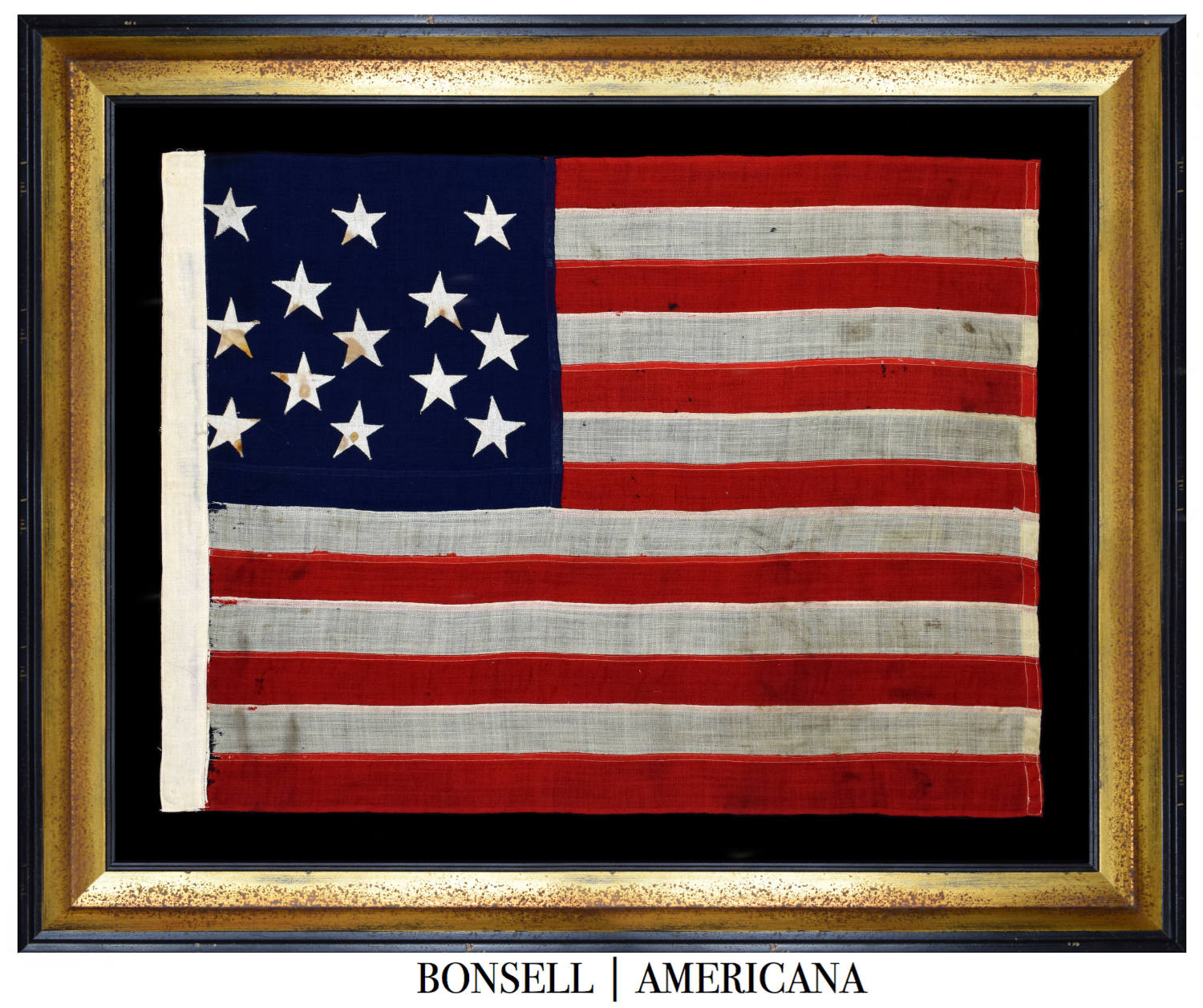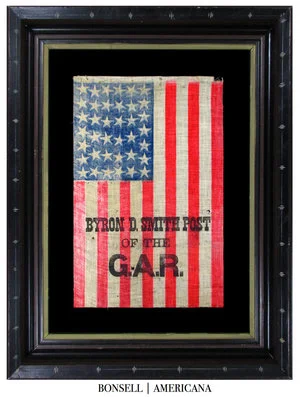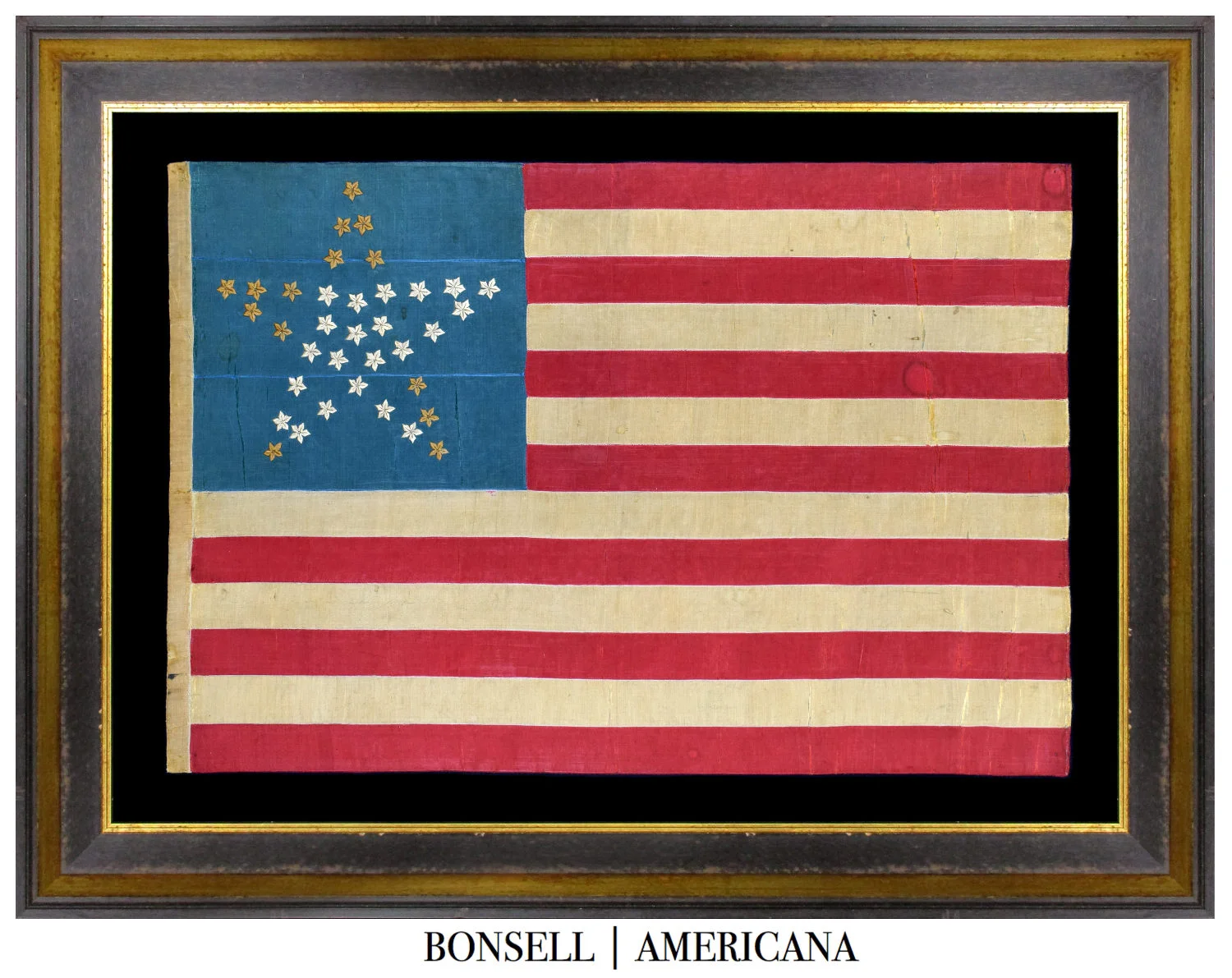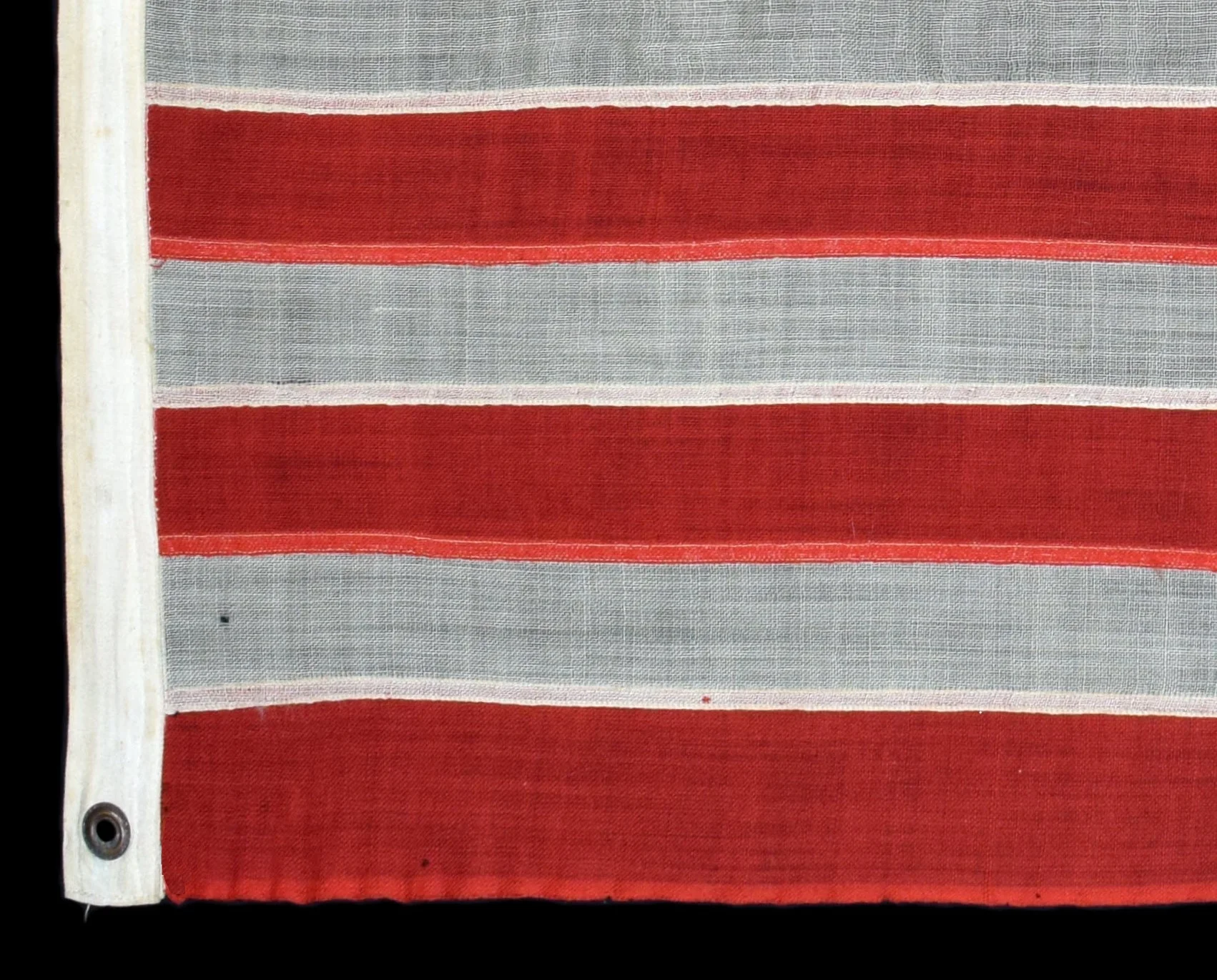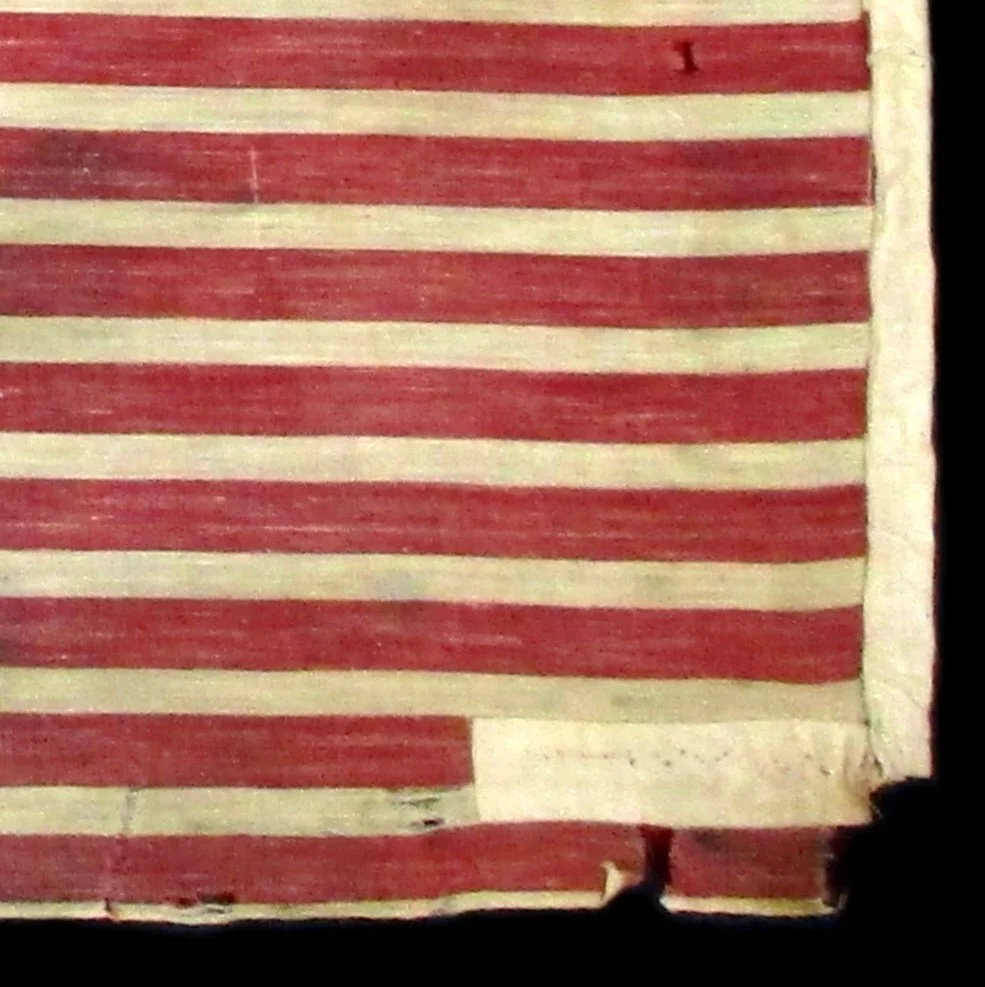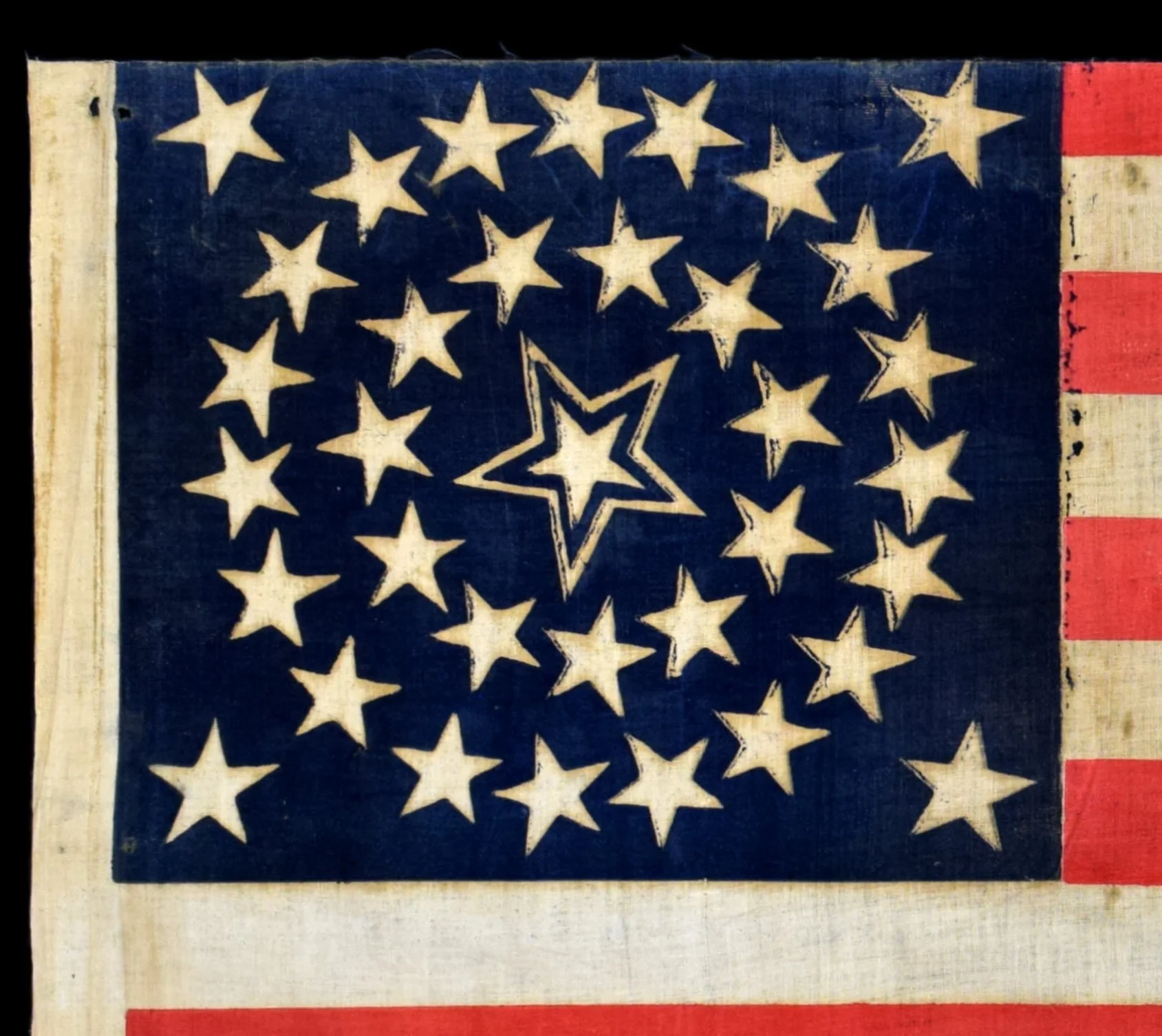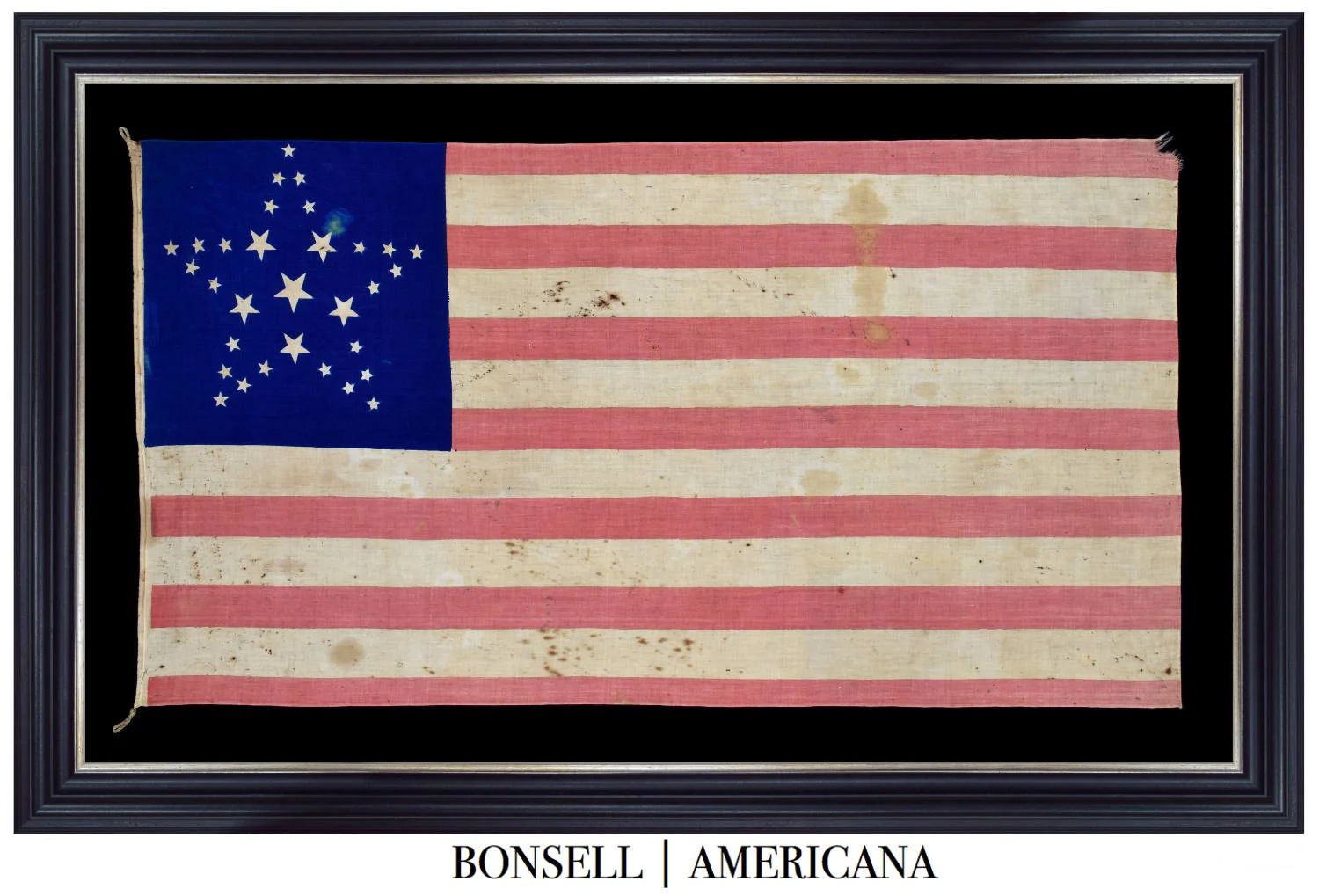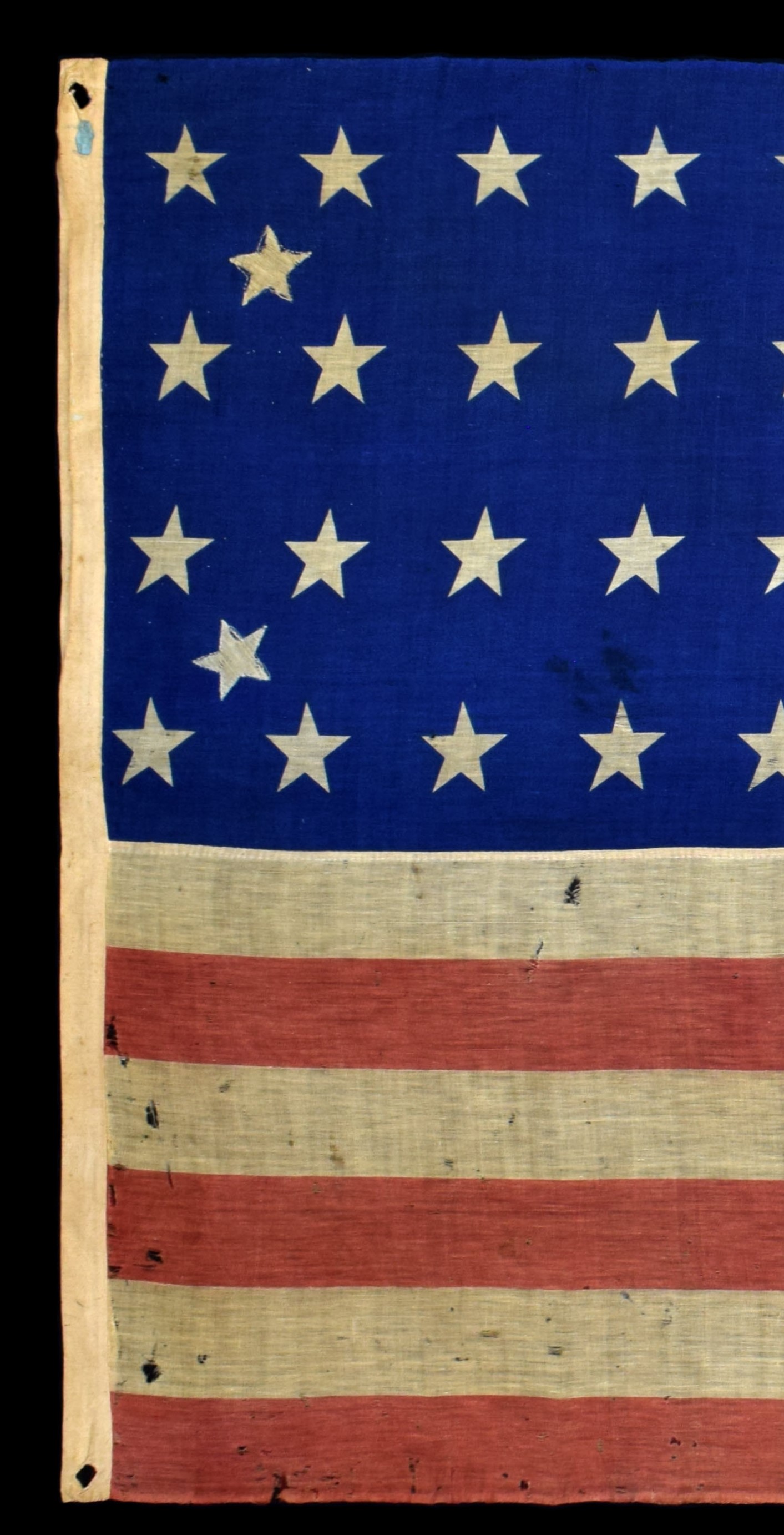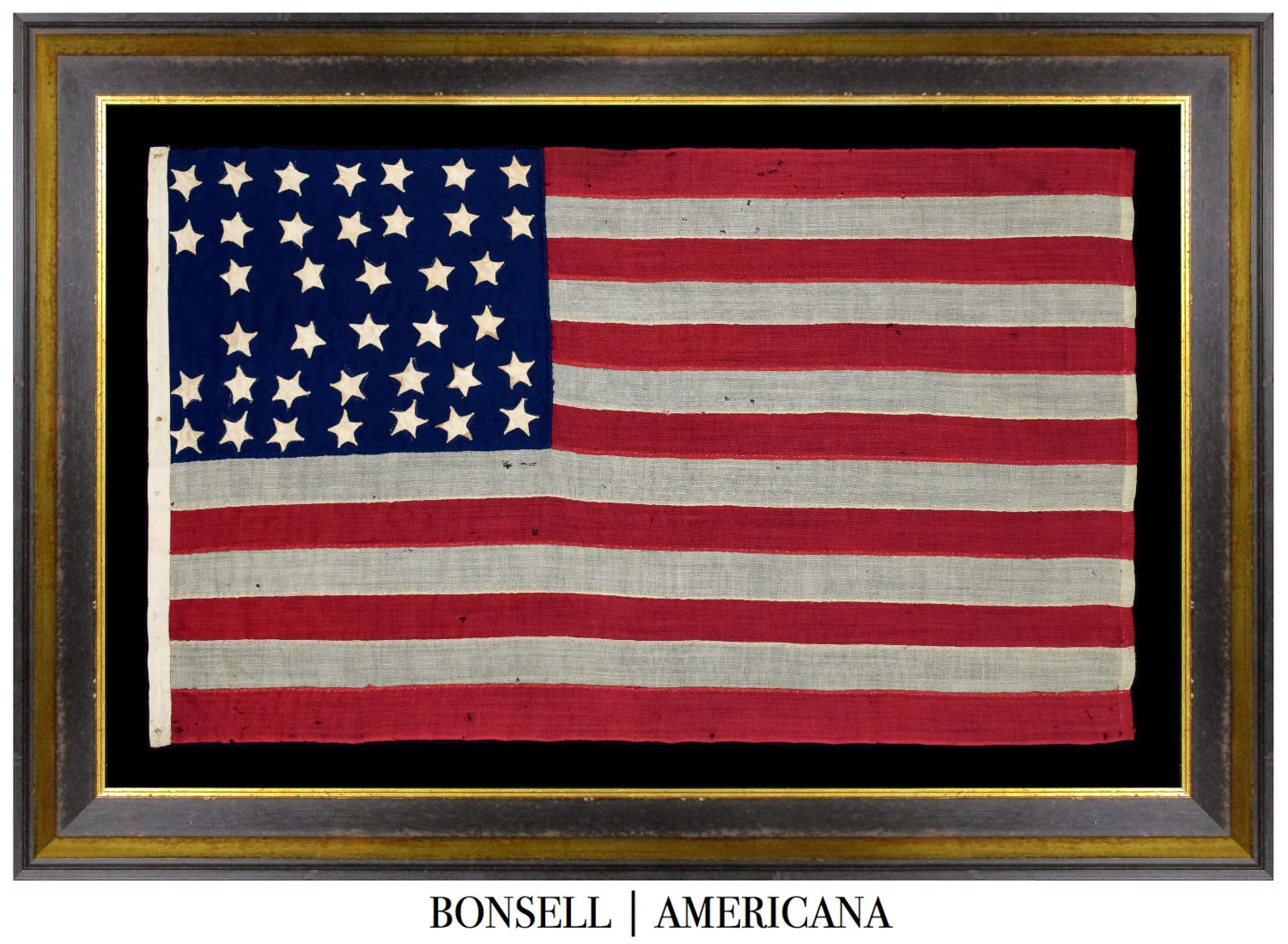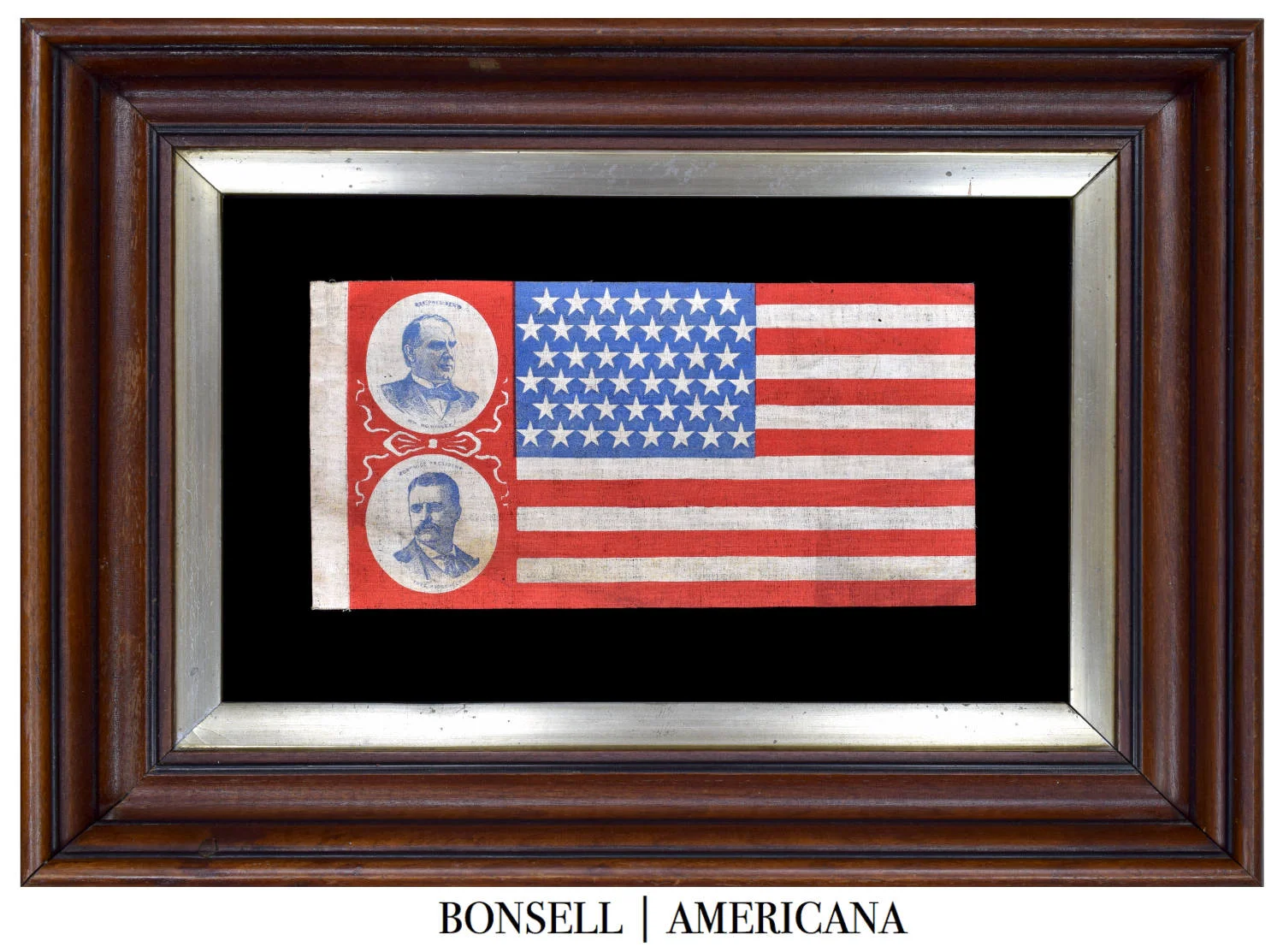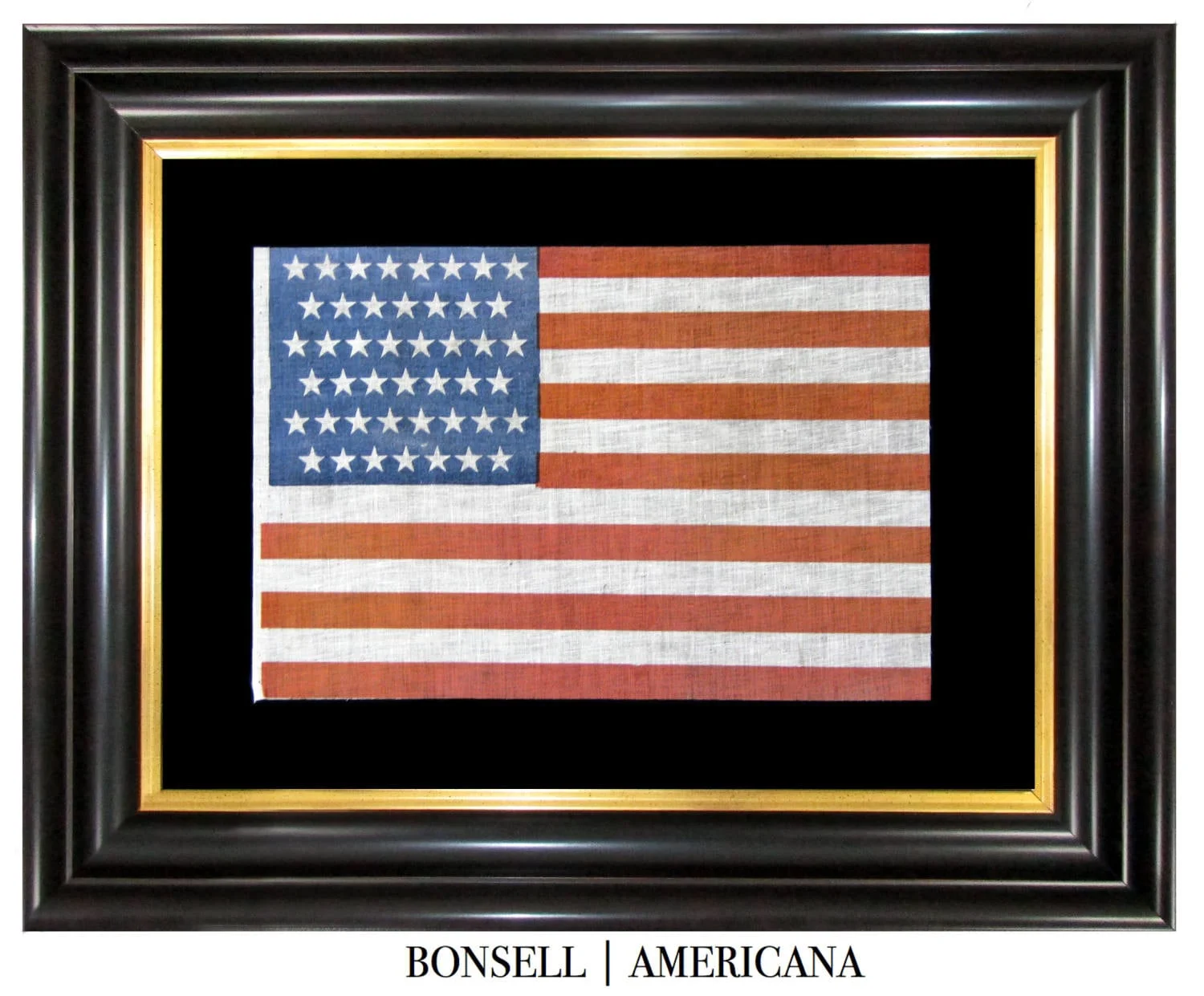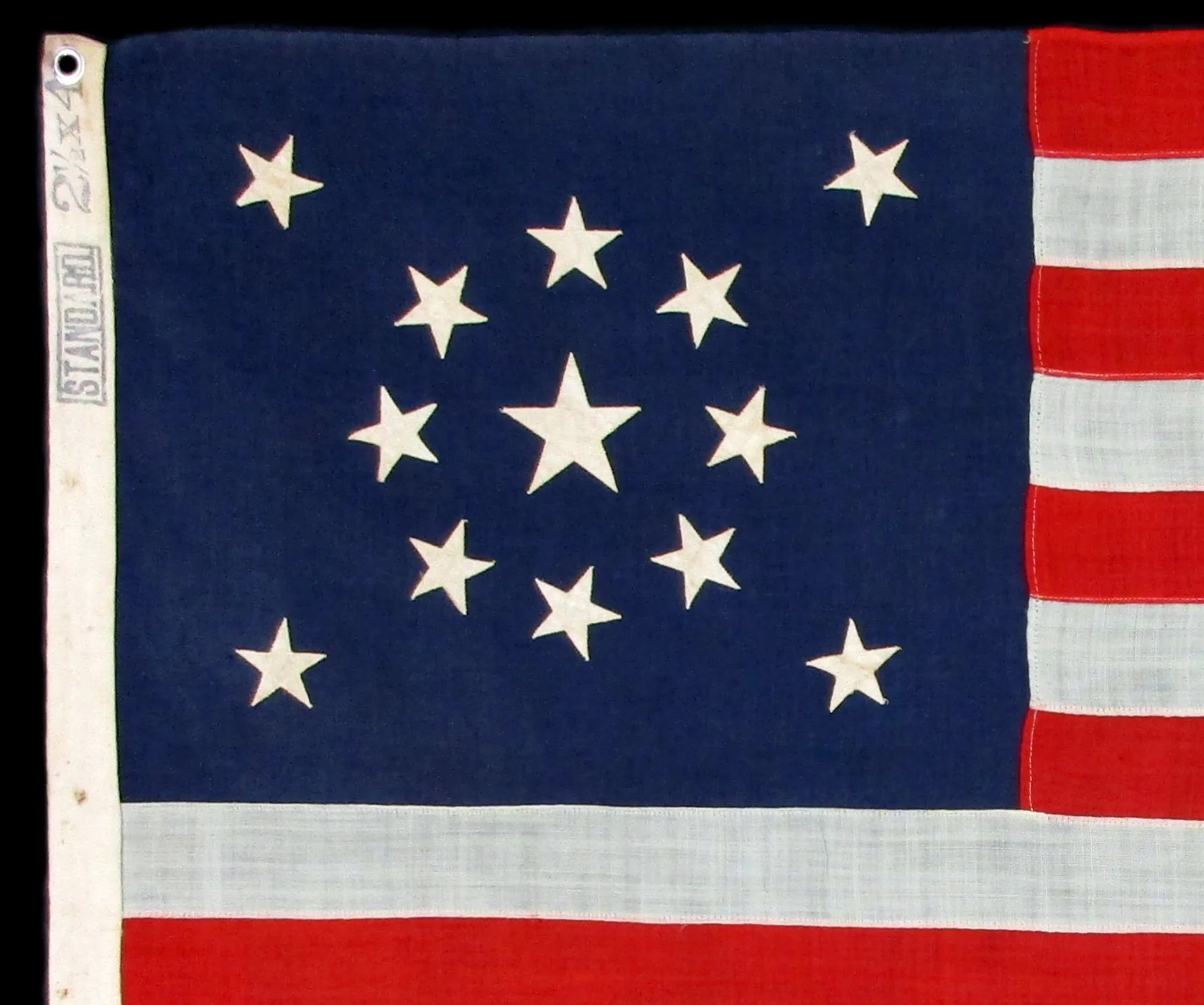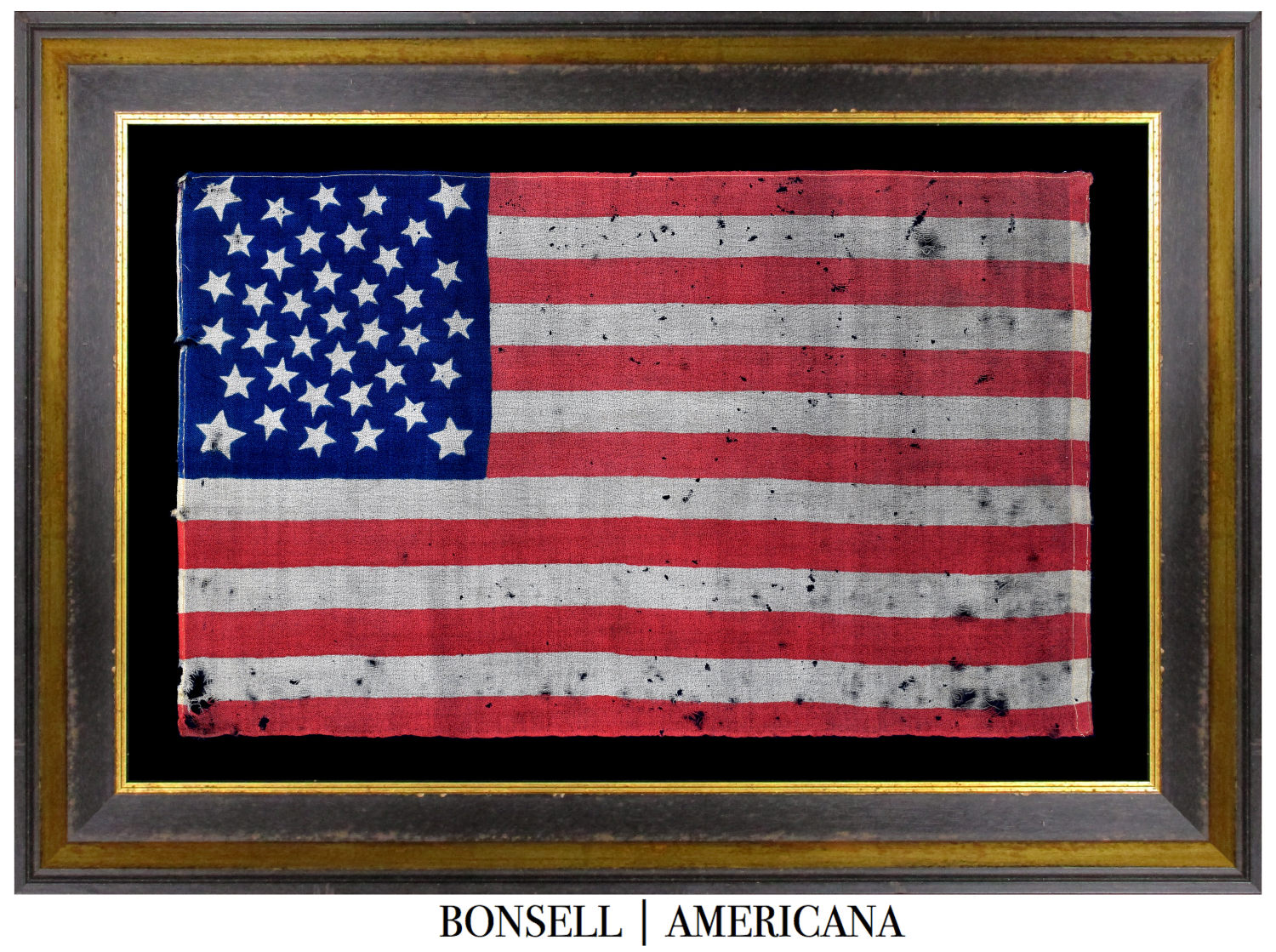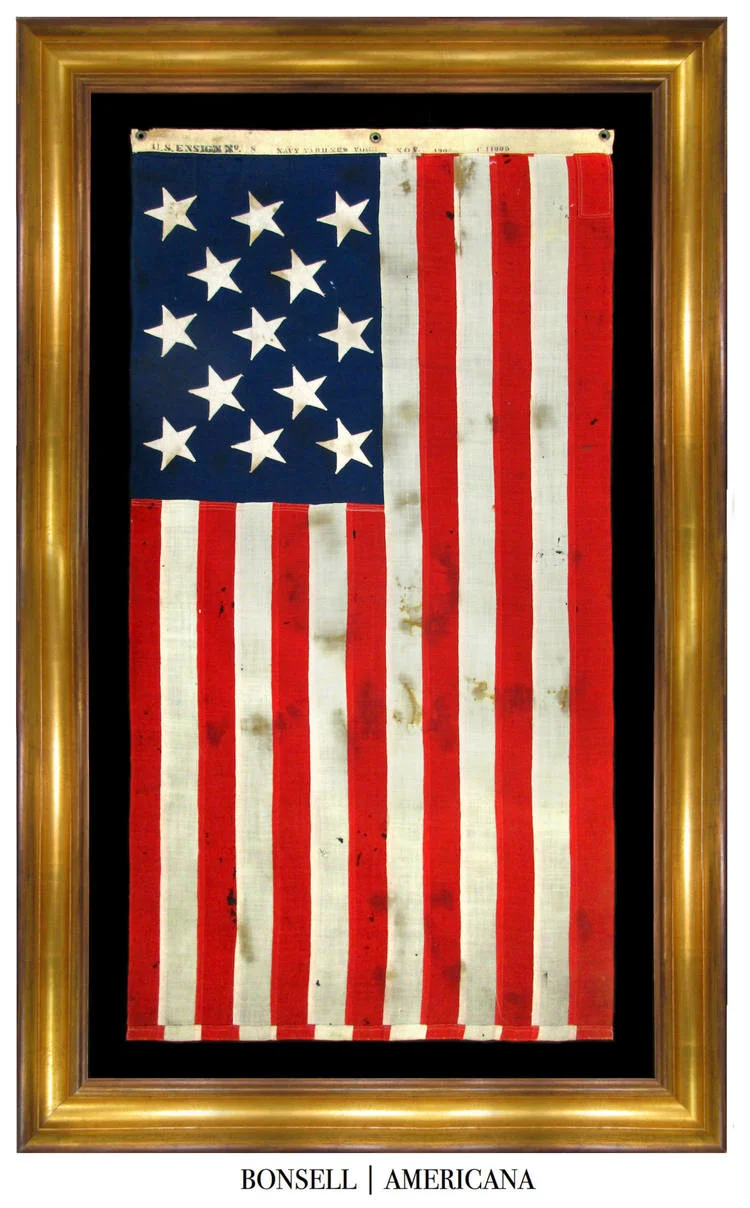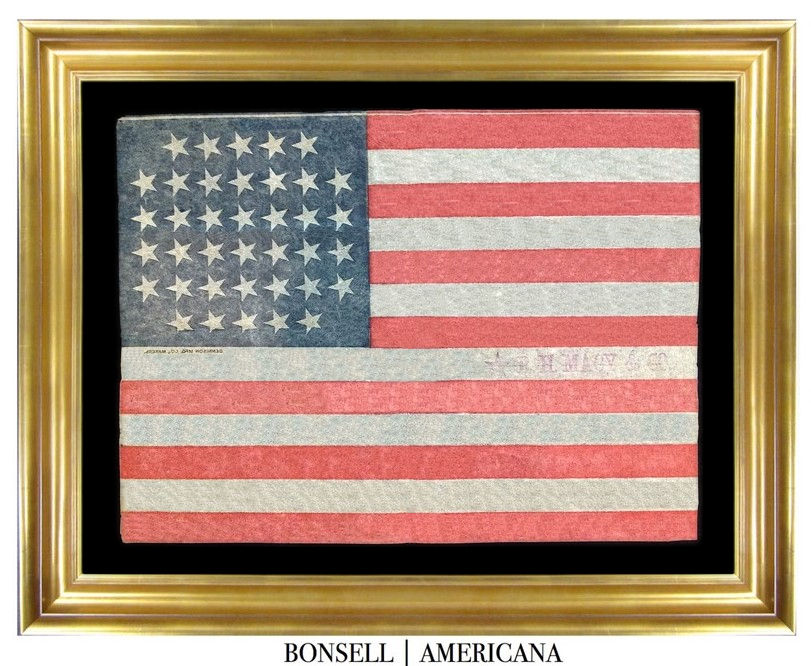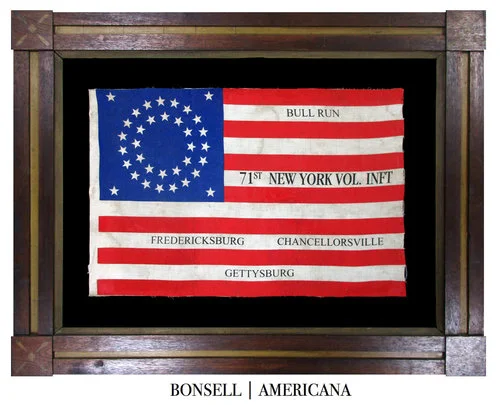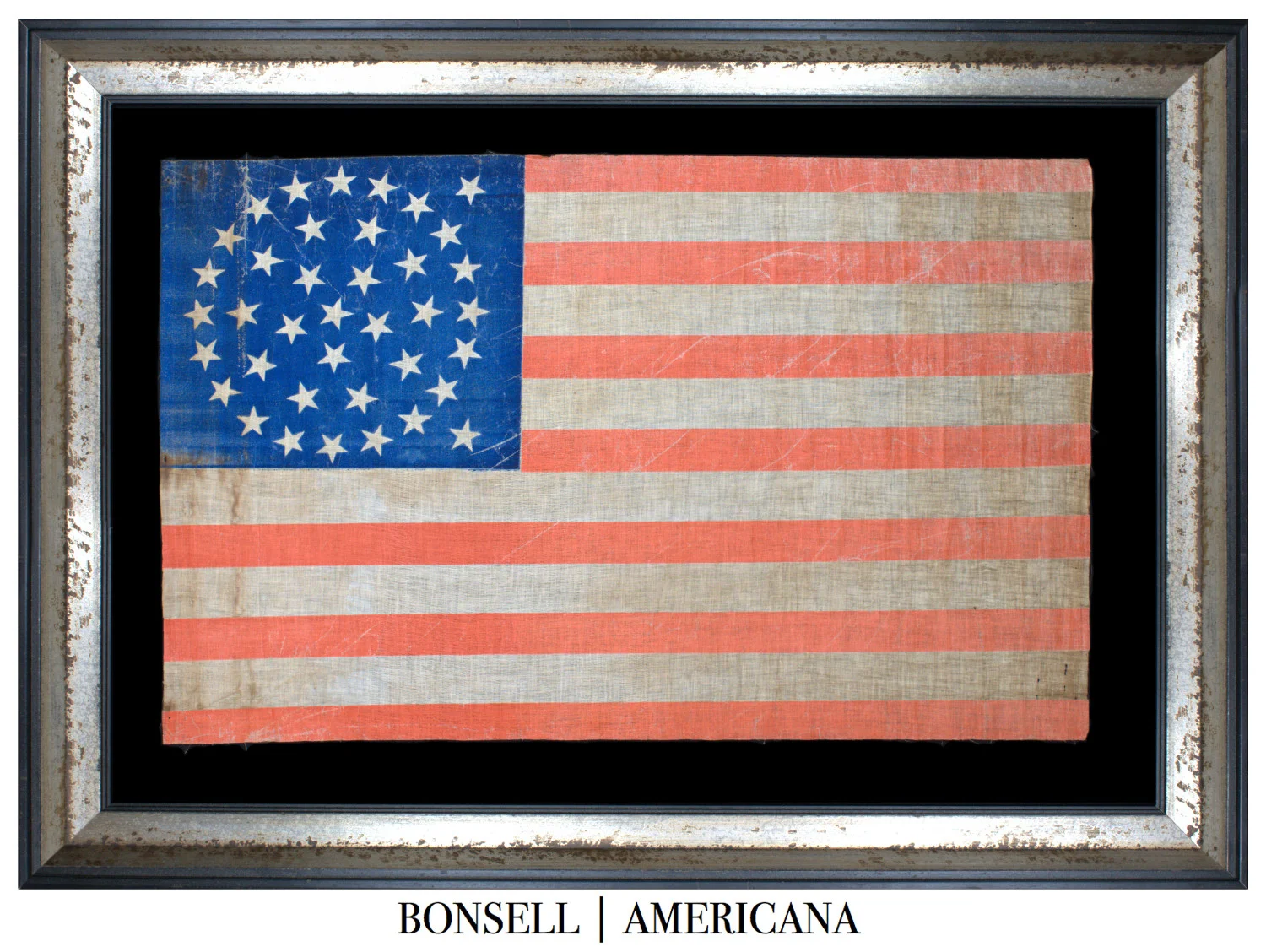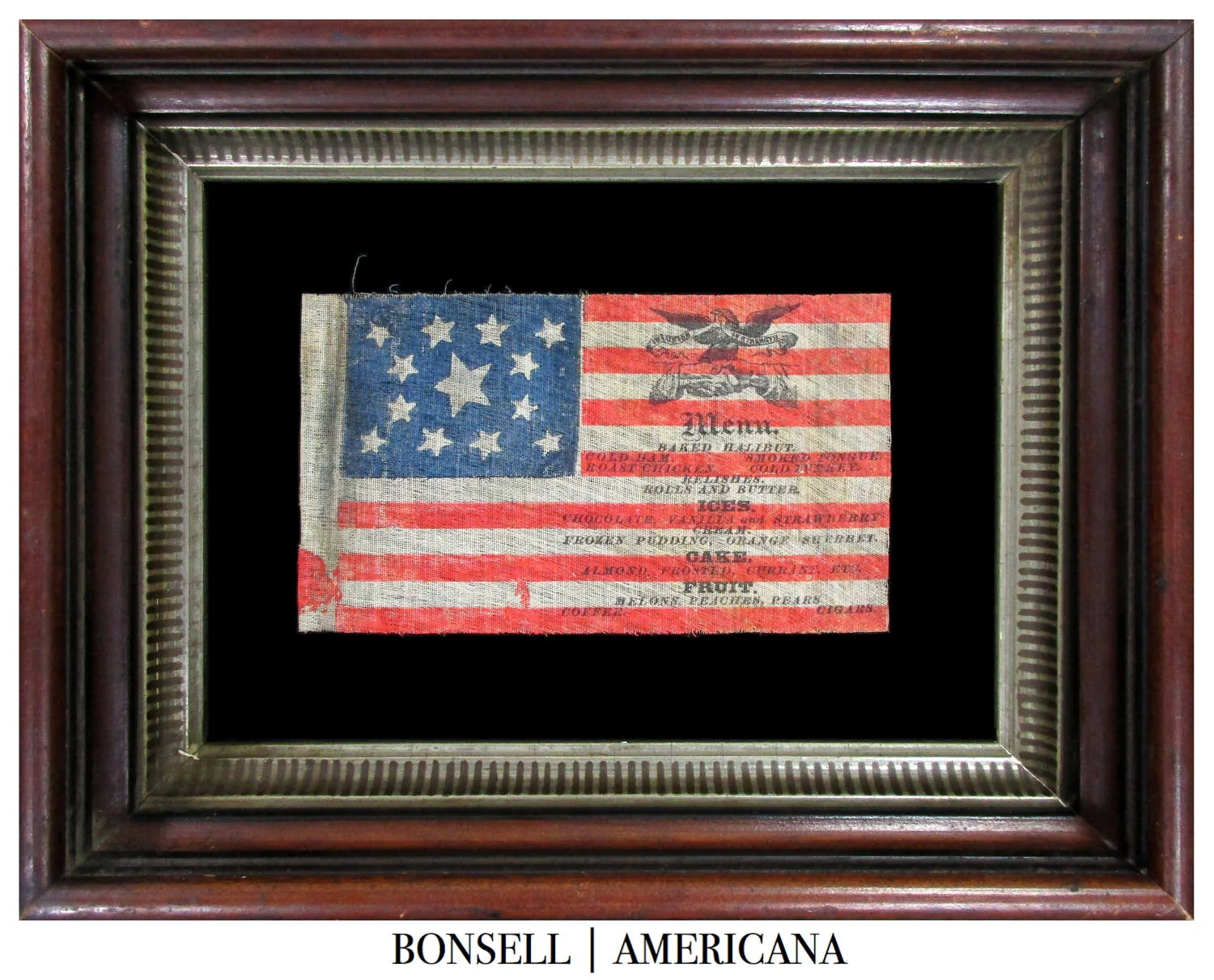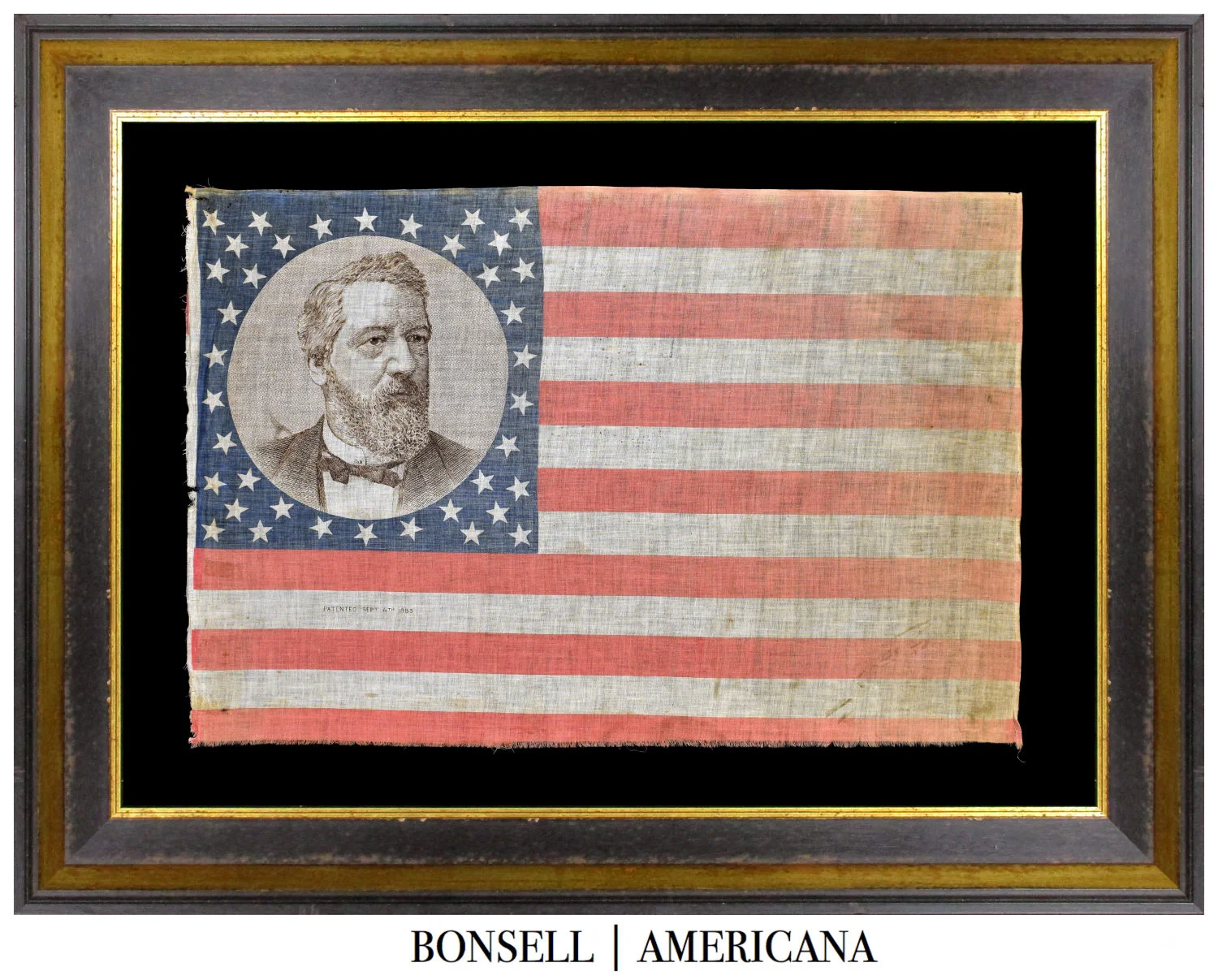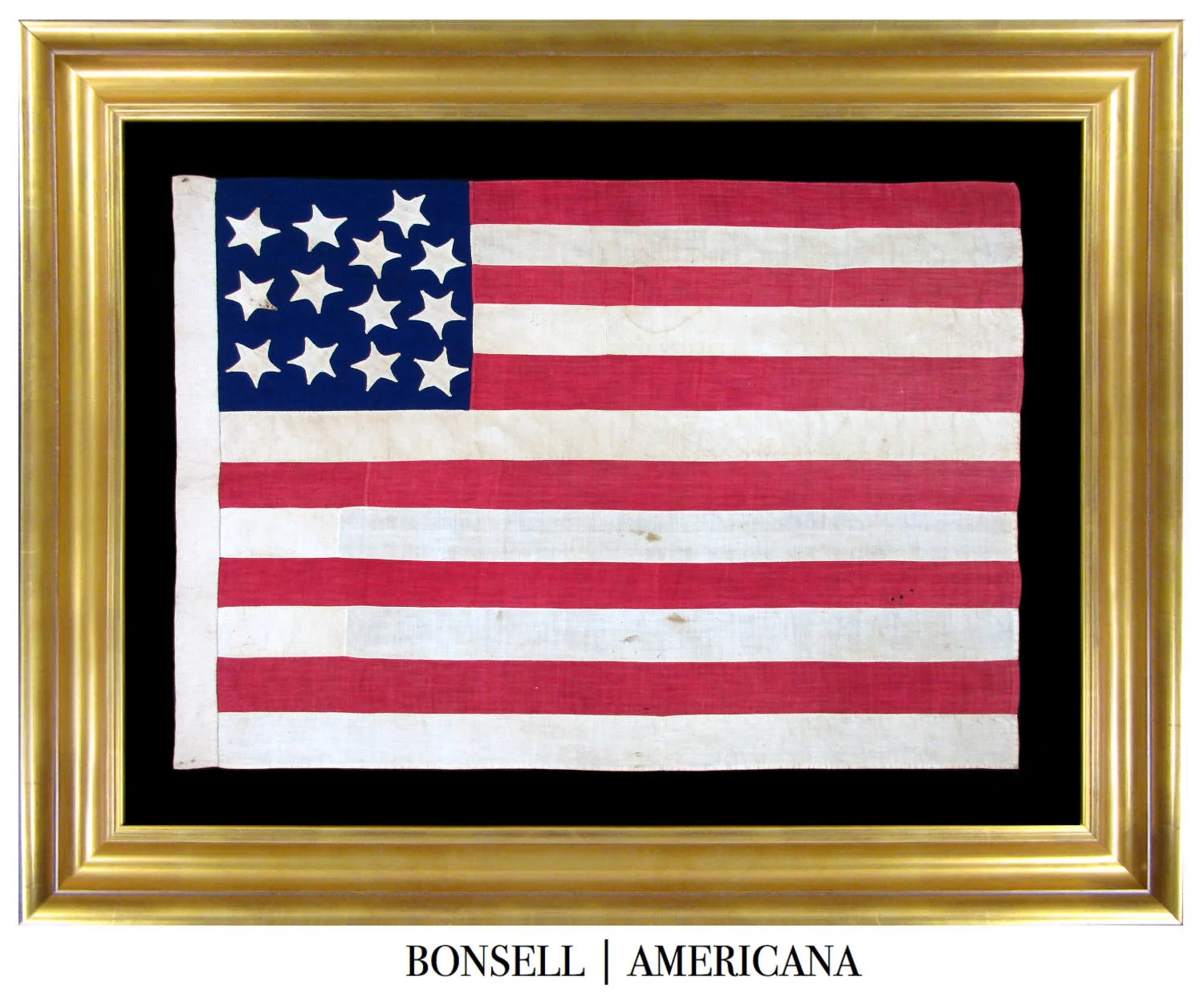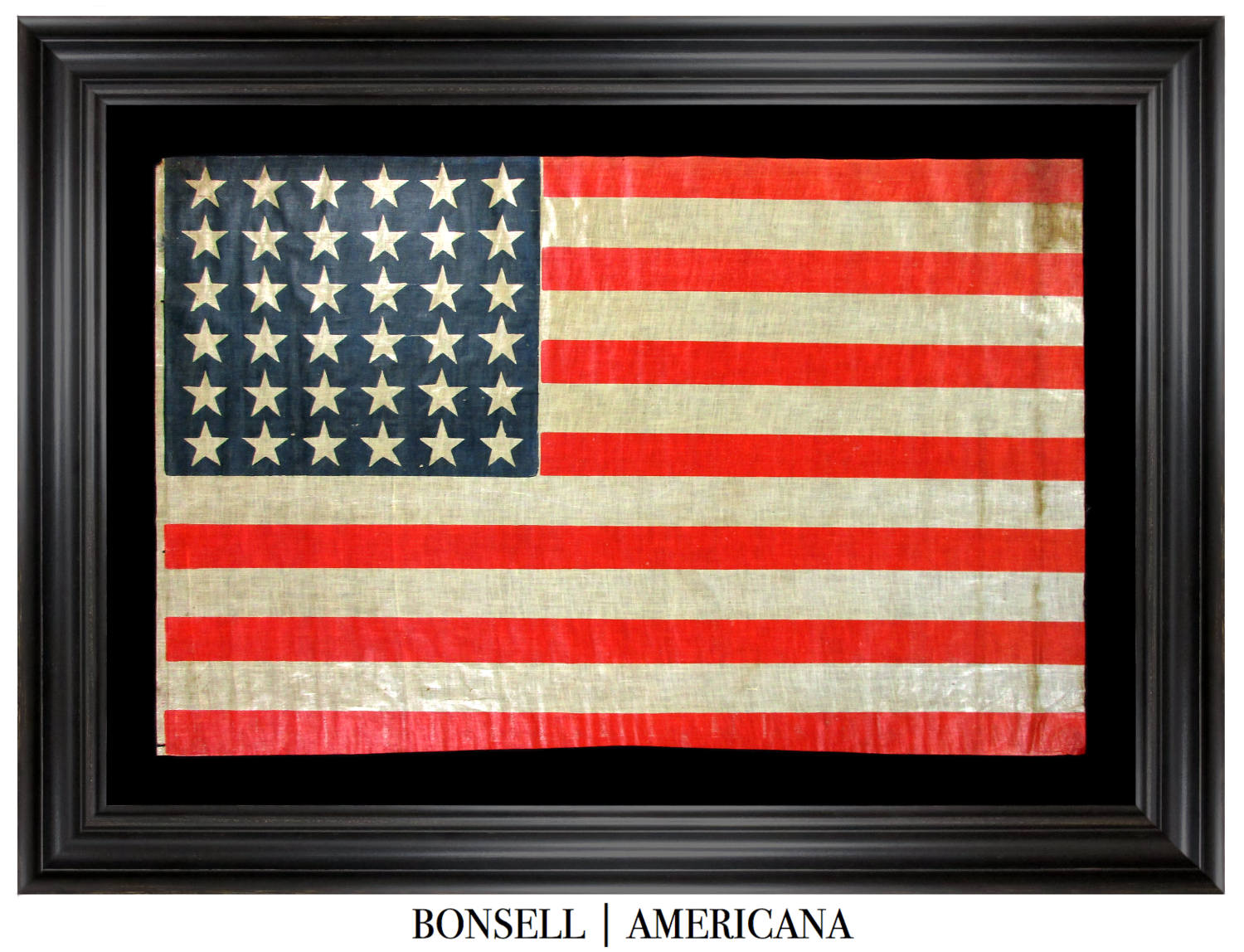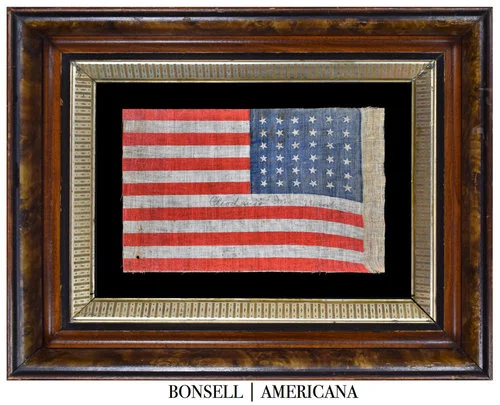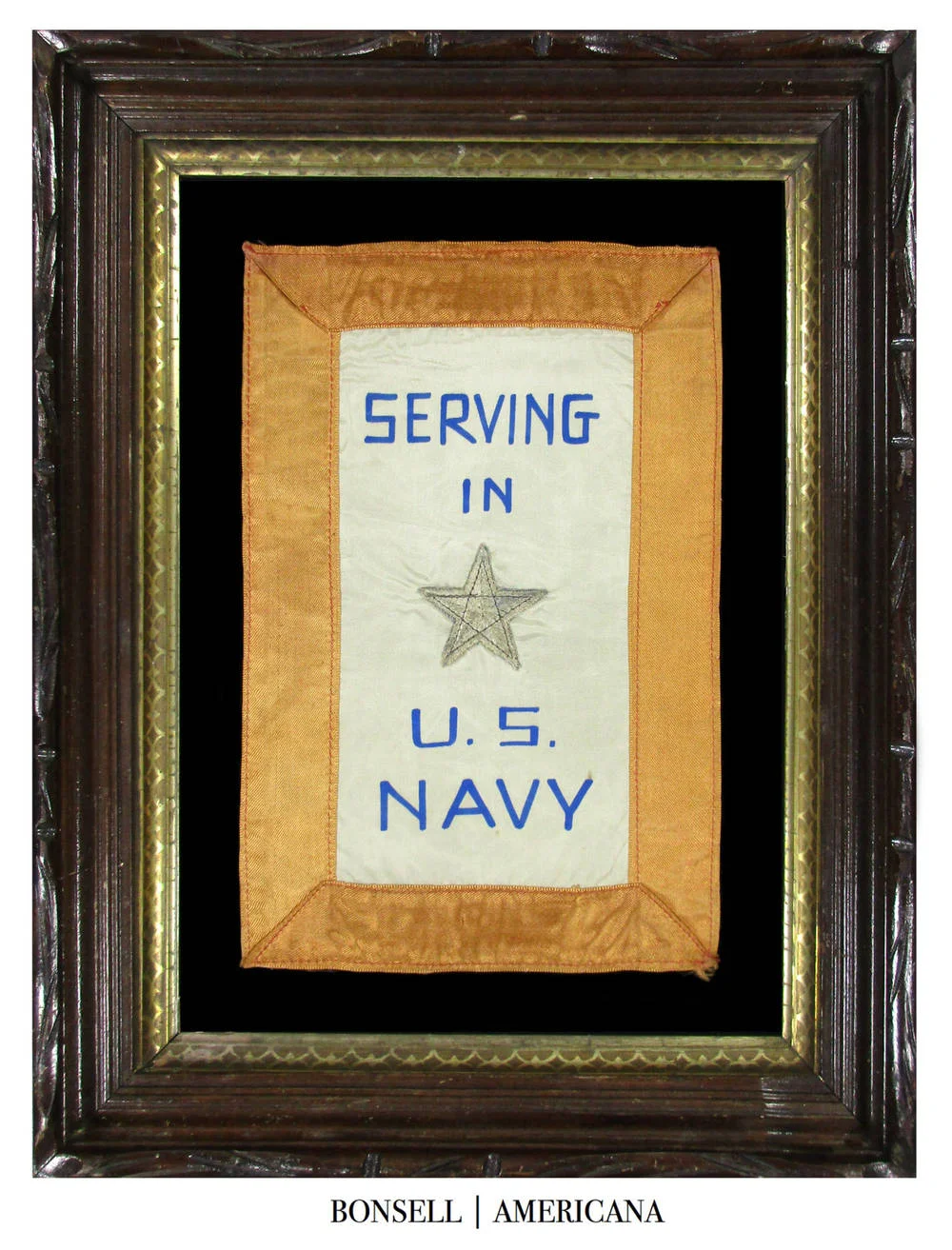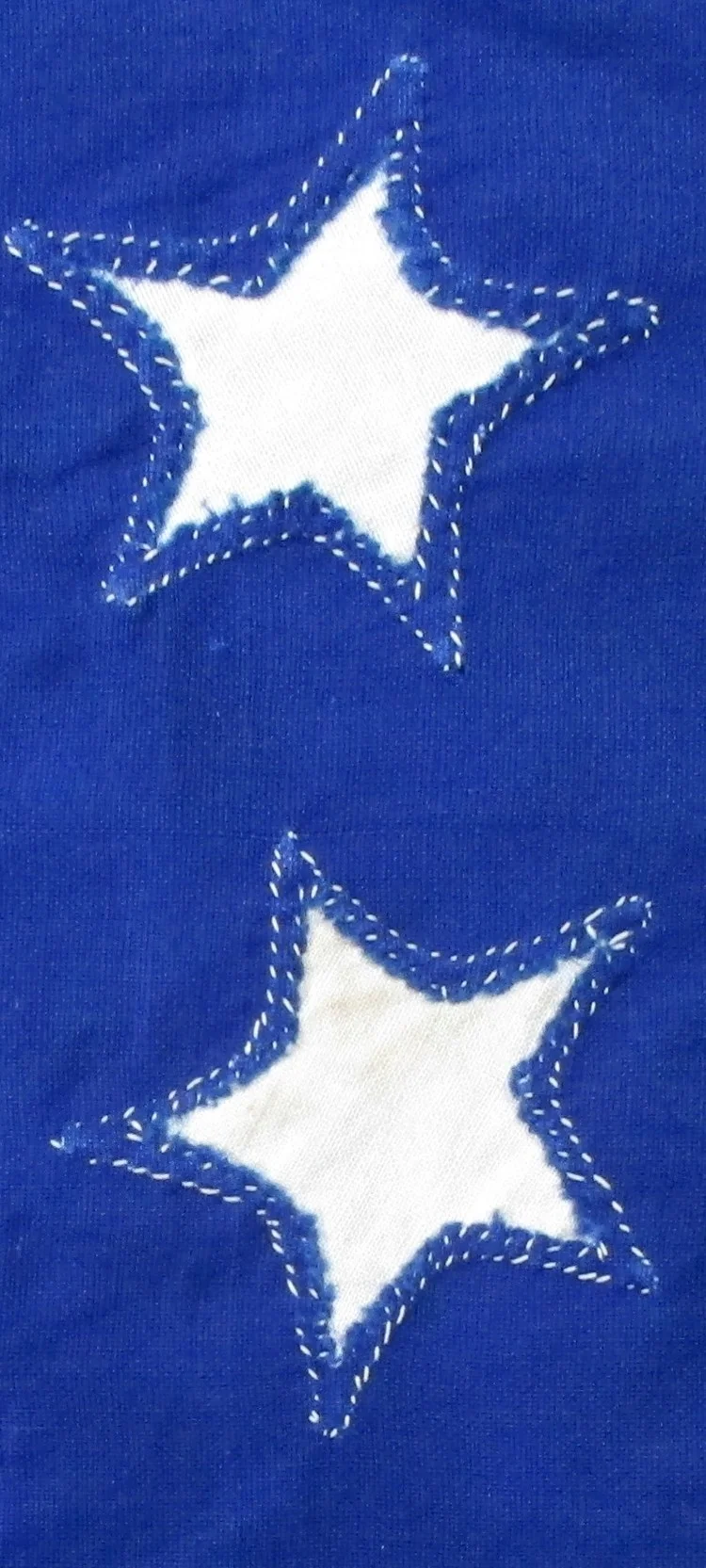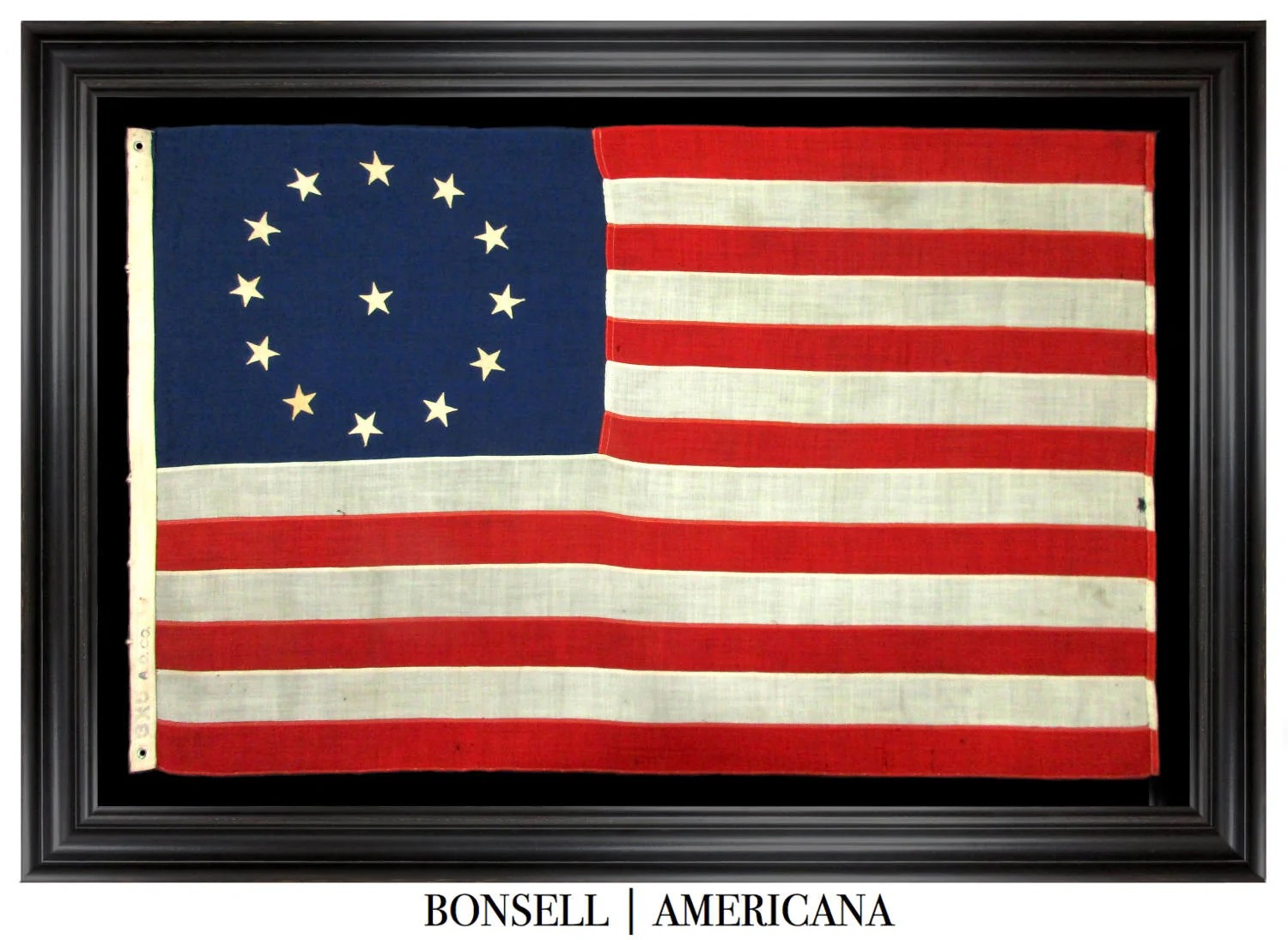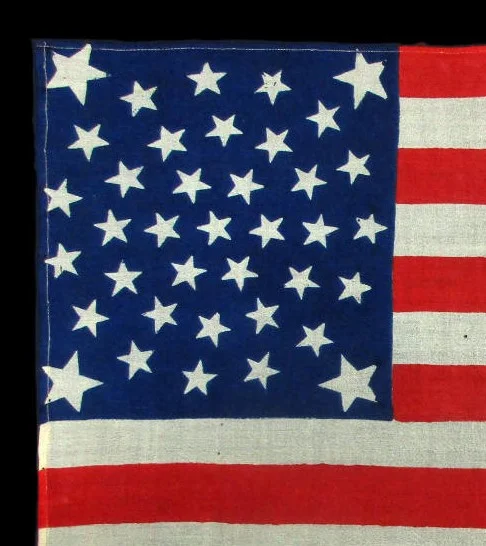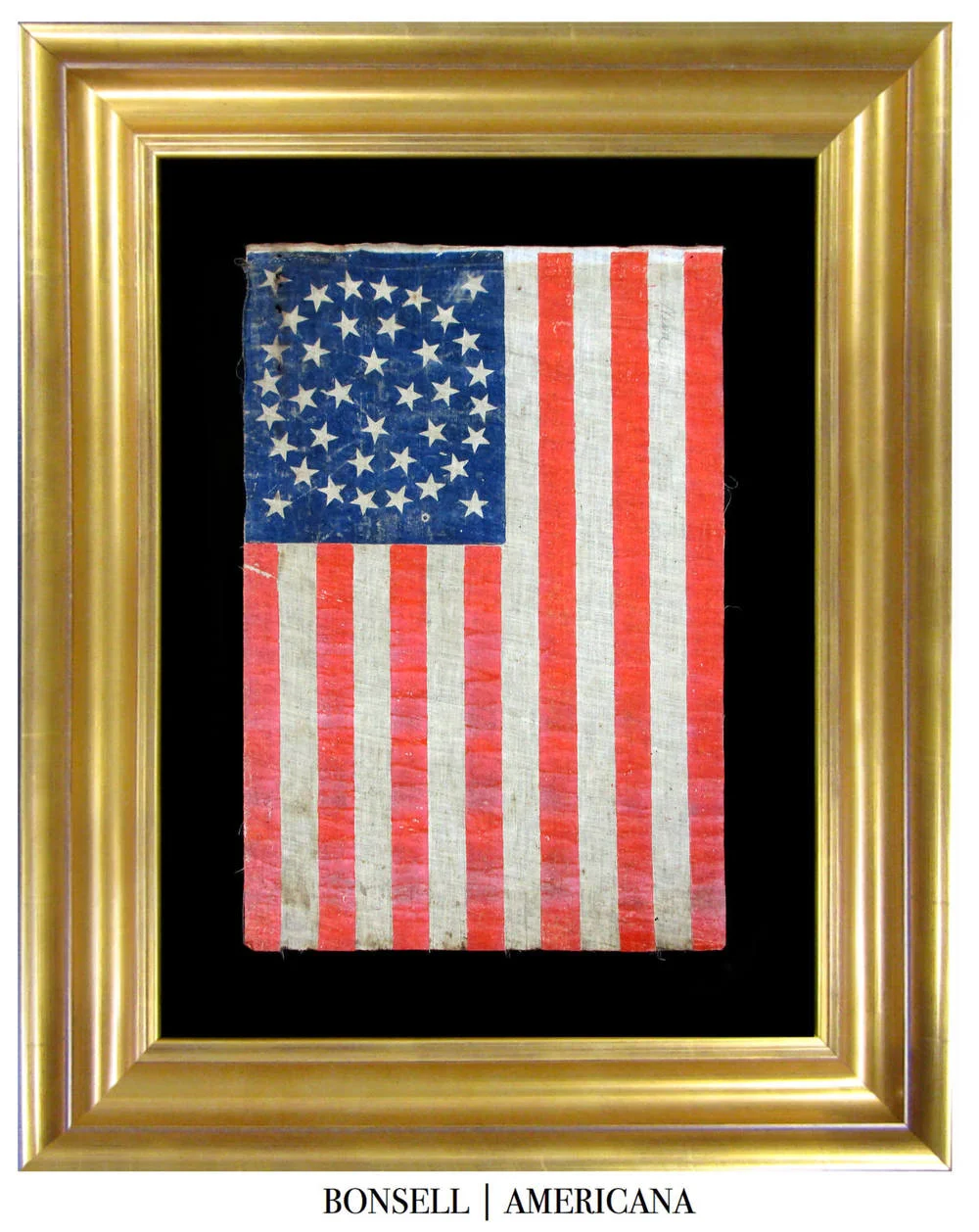ANTIQUE FLAG GLOSSARY
Beehive Pattern:
A beehive pattern is a star configuration that resembles a beehive. It is an extremely rare pattern, and only known to exist on thirty-eight and forty-two star flags.
Bleed:
Most parade flags have a clear obverse and reverse. The obverse is the side that has clear printing and meant to be the front, while the reverse is the side that includes only a very feint bleed through the fabric of the flag.
Blood Stripe:
A blood stripe is a red stripe that is positioned directly underneath of the canton, instead of a white stripes (as generally is standard). Blood stripes were sometimes intentionally placed, so as to symbolize that the US is at war. But, they were also sometimes placed by accident. Blood stripes are sometimes also referred to as war stripes.
Bunting:
Bunting is strong, loosely woven material, and is often used for making flags.
Camp Colors:
A camp color is a flag of a military unit.
Canton:
A canton of a US flag is the combination of the blue background and stars. The canton typically rests on the 7th stripe from the top, and is around one-fourth of the total area of the flag.
Center Point:
The center point of a flag is the location at which the lower-right corner of the canton meets the stripes.
Center Star:
A center star is the star in the middle of the canton (in certain star patterns). It is different than a great star, a term used to describe a star made up of smaller stars. A center star is almost always positioned in the very middle of the canton. In some patterns, the center star is meant to represent the newest state added to the Union.
Commissioning Pennant:
On special occasions, a naval ship will be “dressed” and fly a commissioning pennant on its main mast. The commissioning pennant designates a ship’s status as a commissioned vessel of the navy, the commissioning occurring the first time the pennant is raised. Modern commissioning pennants (i.e., 20th century) include a blue field, seven white stars on the blue field, and single longitudinal stripes of red and white extending from the blue field.
Devices:
A device is a graphic element of a flag. On an American flag, the stars and stripes are the devices.
Double-Appliquéd Flags:
Double-appliquéd flags have stars that are sewn to both sides of the canton.
Dyestuff:
Dyestuff refers to a substance used to color a fabric. Dyestuff may be natural and derived from plants, animals, or minerals. They may also be synthetic, and thus derived from chemical processes.
Economy Flag:
An economy flag is a small, inexpensive, printed flag made for patriotic display.
Exclusionary flag:
An exclusionary flag is one that is meant to exclude a portion of the United States, and includes fewer than the official number of stars for a given time period. During the Civil War, there were Southern flags that excluded stars representing the Northern states, and alternatively there were Northern flags that excluded the stars representing the Southern states.
Fastness:
Fastness is a property of fabric or a dye to maintain its original color without fading, running, or changing.
Field:
A field is the background of a flag, and is the surface on which the stars and stripes are positioned.
Finial:
A finial is a decorative ornament that is positioned at the top of a flag staff.
Fly:
A fly is the vertical edge of the flag that waves in the wind, opposite of the hoist. This term may also refer to the horizontal dimension of the flag.
Francis Hopkinson Pattern:
The Francis Hopkinson pattern refers to a configuration comprising a 3-2-3-2-3 star pattern. It was named after Francis Hopkinson, who is generally considered the designer of the original US flag (not Betsy Ross).
Fringe:
A fringe is a plurality of braided strands sewn to the top, bottom, and fly-end of the flag. They are decorative and add to the visual appeal of the flag.
Grand Army of the Republic:
The Grand Army of the Republic (“GAR”) was a fraternal organization for the veterans of the Union Army, Union Navy, and Marines who served in the Civil War. GAR members provided support to one another and also remembered those who had fallen in battle. It was founded in 1866, peaked in 1890 with almost 500,000 members, and dissolved in 1956 when its last member died. Many antique parade flags include a GAR overprint.
Great Star Pattern:
A Great Star is a large star made of smaller stars. The smaller stars may be a variety of sizes and may be canted in various directions. It is sometimes also referred to as the Grand Luminary pattern.
Grommet:
Grommets are reinforced openings in the hoist of a flag. A halyward may be threaded through the grommets, so that the flag can be raised and lowered.
Guidon:
A guidon is a small military flag and often includes a swallowtail. It identifies the unit, and directs the movement of troops.
Gussets:
A gusset is a reinforcement that is sewn to a corner of a flag.
Haloed Star:
A haloed star is a kind that includes two parts: a bold center star and a surrounding halo. Haloed flags are among the rarest and most attractive of all parade flags.
Halyard:
A halyard is a rope used for moving a flag up-and-down a staff.
Heading:
A heading is a piece of material mounted to the hoist edge of the flag.
Hourglass Pattern:
An hourglass pattern is a configuration that includes top and bottom rows that are outwardly offset, on both sides, from the middle rows. The result is an arrangement that looks like an hourglass. This attractive pattern is most often seen on forty-four star flags, as this number of stars (in an 8-7-7-7-7-8 pattern) most naturally form such a shape.
Jugate Flag:
A jugate flag is one that includes portraits of a pair of political candidates, such as a vice-presidential candidate adjacent to a presidential candidate.
Liberation Flag:
A liberation flag is one that typically dates to WWII, and made by citizens of Britain, France, or other affiliated state combatants to welcome US soldiers. WWII marked the first time that non-Americans made and waved US flags in large numbers. Makers from such countries were generally aware of what a US flag should include, but they typically did not know how big the canton should be, how many stars there should be, how the stars should be arranged, and how many stripes there should be, just to name a few examples.
Lineal Star Pattern:
A linear star pattern is a configuration in which the stars are arranged straight rows and/or columns.
Marking:
A marking is an inscription that is found on some antique flags, and may sometimes be stenciled into place. The marking may include the name of the maker, patent numbers, the size of the flag, or the materials used to make it.
Medallion Star Pattern:
A medallion star pattern is a configuration that includes one or more concentric wreaths of stars. The majority of medallion star patterns date to between 1861 and 1876, but there are many such patterns both before and after this time period. Beginning in the 1890s, this beautiful pattern became much less common, and linear arrangements became the norm.
Naval Ensign:
A naval ensign is a national flag that is flown on a boat or ship, typically on the stern of the vessel. In the 18th century and much of the 19th century, the US flag was primarily considered a maritime flag, and for this reason, the national flag used on land is the same as the one used at sea.
Notched Star Pattern:
A notched star pattern is one in which the stars are arranged linearly, but with open star gaps. The gaps are typically large enough that they could later be filled with stars, as additional states joined the Union.
Obverse:
The obverse is the front of a flag. Today, this is considered the side showing the canton to the left. At the time many antique flags were made, they had no clear front or back, and the canton may sometimes appear on what we today consider the reverse.
Open Sleeve:
An open sleeve is a tunnel of material, along the hoist edge, that receives the staff.
Outliers:
An outlier is a star that is noticeably removed from the primary star pattern. Outliers are commonly positioned in corners of the canton on flags with medallion patterns, great star patterns, and beehive patterns.
Overprint:
An overprint is printing on the face of the flag, either on its canton or its stripes. Overprinted flags are typically made of either cotton or paper, and typically date to between 1860 and the early 1900s. They cover a variety of topics, including political candidates, political organizations, commercial advertisements, and historic events.
Parade Flag:
A parade flag is a small scale flag intended for short term use. They were meant to be used for only a short time at parades, celebrations, rallies, and inaugurations, to name just a few examples. They were typically attached to a staff with glue, nails, and/or a friction wedge designed into the staff.
Portrait Flag:
A portrait flag is one that includes an image of one or more political candidates.
Random Star Pattern:
A random star pattern is a configuration that does not form any noticeable rows or shapes.
Rectilinear Star Pattern:
A rectilinear star pattern is a configuration in which the stars are aligned, both in horizontal rows and vertical columns.
Reverse:
The reverse is the back of the flag.
Reverse Mount:
A reverse mount is one in which the canton of a US flag is positioned in the upper-right corner. Current flags ethics state that the canton should always be placed on upper-left, but such a requirement did not exist in the 19th century. For this reason, some antique flags display best in a reverse mount, including flags that have printing and images on one side, flags that are more visually attractive on one side, and flags that are homemade.
Service Flag:
A service flag is an official banner that is displayed in support of a family member who is serving in the military. Service flags have a white field with a red border, and a blue star for each family member serving in the Armed Forces of the US during any period of war. Service flags were first displayed during World War I, and have been displayed in every US war since.
Sewn Flag:
A sewn flag is one that is made by sewing separate pieces of fabric together, in contrast to printing the flag on a single piece of fabric.
Single-Appliquéd Flag:
A single-appliquéd flag is one that has stars sewn to just one side of the canton. When this approach is used, the canton is cut-away from behind each star and then hemmed. By doing this, the single piece of material used for each star can be seen on both sides of the flag. Single-appliquéd flags are much rarer than double-appliquéd flags, and further they tend to have a more attractive, folksier appearance.
Sleeve:
A sleeve is a piece of cloth that is doubled over, so as to reinforce the hoist and receive the staff.
Swallowtail:
A swallowtail is a v-shaped fly end. It helps a flag remain straight when flowing in the wind, and helps make a flag more easily identifiable.
Third Maryland Pattern:
The 3rd Maryland pattern is a configuration of a single center star surrounded by a wreath of twelve stars. A flag with this pattern may have been carried by the 3rd Maryland Regiment at the Battle of Cowpens on January 17th, 1781. Thirteen-star antique flags rarely exhibit this pattern.
Trumbull Pattern:
The Trumbull pattern is a configuration with a single center star surrounded by a square of twelve stars. John Trumbull, a presidential aide to Washington, painted several flags with this configuration in the 18th century. Thirteen-star antique flags rarely exhibit this flag.
Union:
The union of a US flag is the combination of the stars and the field of blue. It symbolizes the union of the states.
Vertical Mount:
A vertical mount is a kind of mount in which the flag is hung vertically, rather than horizontally. In most cases, when the flag is in a vertical position, the canton should be positioned in the upper-left corner.
Vexillogy:
Vexillogy is the study of flags, their history, and their symbolism.
Whip-stitched Grommets:
A whip-stitched grommet is hand-sewn grommet. Whip-stitched grommets were commonly used on flags dating to the Civil War, and almost exclusively on flags dating prior thereto.
Yacht Ensign:
A yacht ensign is one that is used in place of a traditional US flag on private pleasure craft in US waters. Such flags include a canted anchor surrounded by a circular wreath of thirteen stars.

